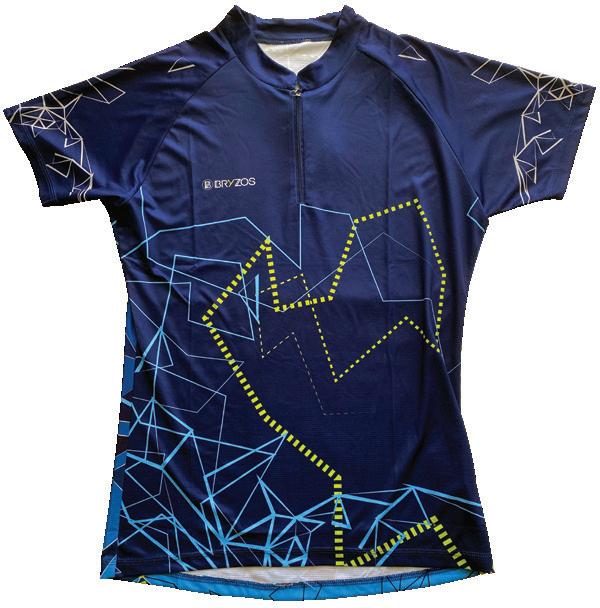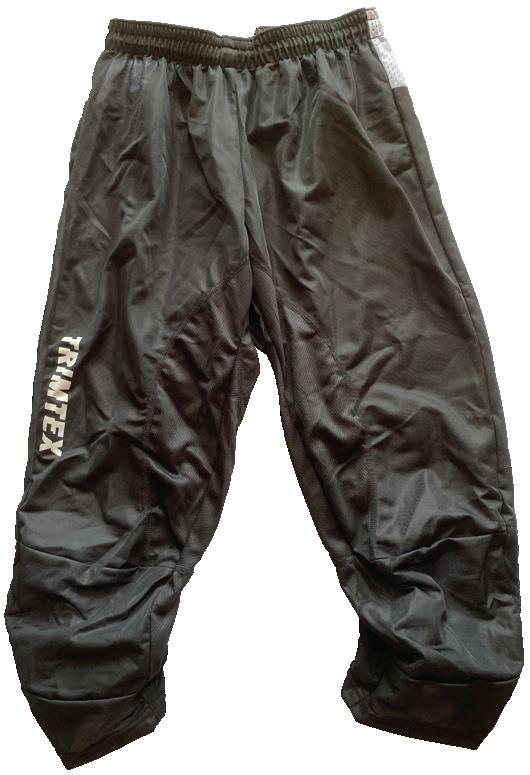
•Australian Championships
• MTBO Championships
• Coach in Residence
• Sydney City Race






•Australian Championships
• MTBO Championships
• Coach in Residence
• Sydney City Race





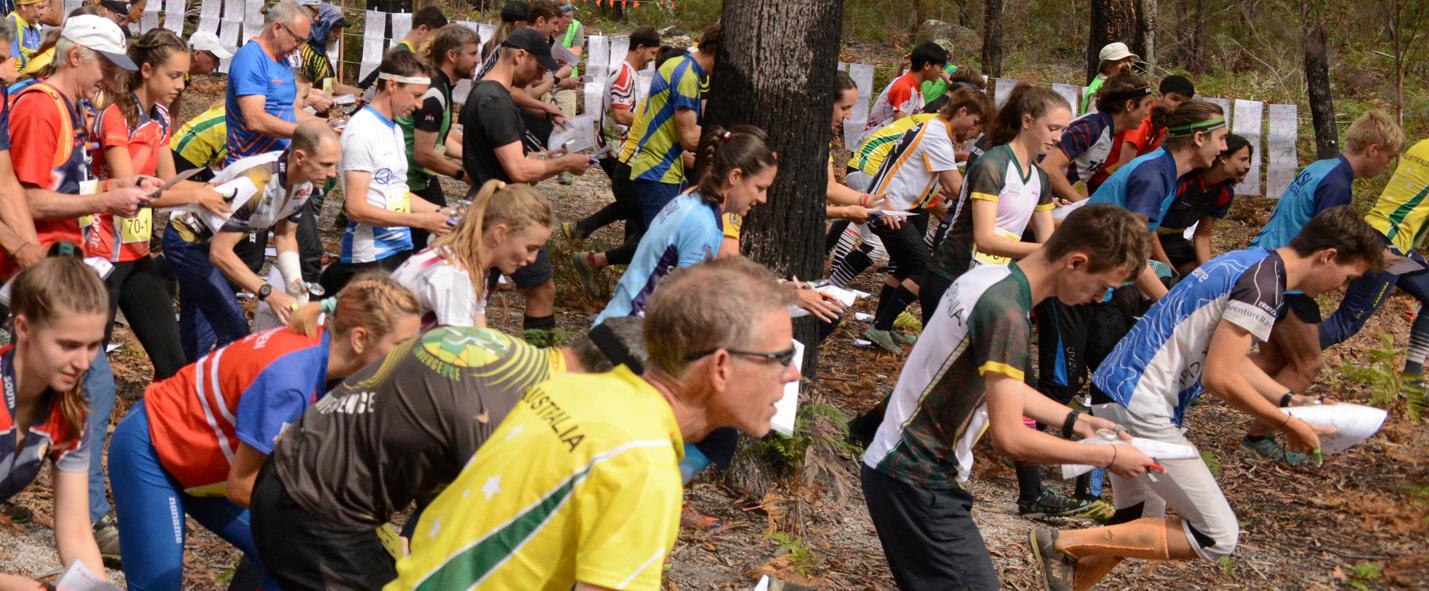
The Australian Sports Commission (ASC) develops, supports and invests in sport at all levels in Australia. Orienteering Australia has worked closely with ASC to develop orienteering from community participation to high-level performance. Each year Orienteering Australia receivesfunding to support participation in orienteering across Australia.
Work has started on the Beginner Instruction for Everyone project! This important project aims to establish a standardised approach to beginner instruction and event design, ensuring consistency and accessibility across the country. We hope it creates inclusive and engaging environments for first-time orienteers, and increases retention rates.
A working group has begun creating orienteering’s first Reconciliation Action Plan. This RAP will guide orienteering throughout Australia to be more mindful and supportive of those whose Ancestors moved through the bush before us. Working on the core pillars of relationships, respect and opportunities will help with reconciliation for Aboriginal and Torres Strait Islander Peoples connected with orienteering now and in the future, and it supports the national reconciliation movement.
We thank ASC for their ongoing support of orienteering in Australia.






MIKE DOWLING – CHAIR OA BOARD

Elsewhere in this edition of The Australian Orienteer you will red about two very successful major events on our annual calendar, namely the Australian Championships week centred around Armidale and Uralla in northern NSW, and the Australian Mountain Bike Orienteering Championships in and around Canberra, ACT.While I did not get to either event, by all reports the events were a feast of great orienteering and the weather was kind to participants and organisers. On behalf of the board, I extend a very sincere thank you and an expression of gratitude for all the many volunteers who put in many hours of hard work to ensure the success of both carnivals.Thank you, Nick Dent and Ron Pallas, for your leadership of the Australian Championships week, and thank you Marina Iskhakova for your leadership of the Australian Mountain Bike Orienteering Championships.
I hope that if you took part in either event you made an effort to thank some of the many volunteers who allowed you to enjoy the events. Both carnivals received substantial support from the Moira Whiteside Bequest. For more information about the wonderful legacy of the bequest from Moira Whiteside please visit the Whiteside Bequest page on the OA website.The board continues to reflect and develop how we can make best use of the wonderful bequest by Moira Whiteside to provide a lasting legacy for Australian orienteering in supporting the organisation and participation in our major events.
The board continues to work on improving its governance. A major focus through this year has been around risks in our sport to ensure we have the optimal environment for good management of our sport, and how we engage with our sport with a participant focus in its many forms.The board is developing two risk frameworks around finance and audit, and legality and safety.This important work is being led by director Andrea Harris. Connected to this and other governance enhancements, the board anticipates some further amendments to our constitution at the 2025 annual general meeting now that we are structured as a company limited by guarantee. These amendments will largely be driven from our annual governance audit by the Australian Sports Commission. It is anticipated that initial details of these amendments will be part of the OA annual consultation workshops across the weeks of late November/early December as this edition hits your inbox or mail box. Details of the four workshops about governance and finance,

Proudly supported by

events, performance, and opportunities and relationships will be on Eventor. I encourage you to join the workshops to find out what the OA board and office are doing on your behalf.
The board has adopted a Communication and Social Media Plan which will guide how OA will communicate via its media channels to internal and external audiences.This will guide and assist our wonderful communications and marketing manager, Liz Leung, and the OA office in further enhancing our communication with you. Liz has been a great asset to our team, and data shows that her work with OA has significantly improved the quality and breath of our communication to both internal and external audiences. Liz is one of the great team of OA officers who do much of the operational work on behalf of the board, led by Arpad our general manager. As chair of the board, I am extremely grateful that we have such a great team.Thank you one and all.
Elsewhere within our operational activities our participation manager, Daniel Stott, is working hard to lead the implementation of our whole of sport Participation Plan. We will have the first meeting of people who have volunteered to work together to develop our Reconciliation Action Plan.This is an exciting and important project for us as a sport. In addition, we will have a project manager for our Beginner Orienteering Instruction project that will act as a lead in to the Learn to Orienteer program. We are delighted we have reached agreement with Bridget Uppill to further develop the fantastic Kid-O product aimed at helping younger children develop orienteering skills. Anecdotally, I am hearing there is a growing need for accredited coaches due to demand from people interested in learning and engaging in our sport in programs such as Learn to Orienteer. Becoming an accredited coach is a fantastic way to improve your own orienteering skills, and I would encourage you to sign up to our Orienteering Learning Centre and become accredited as an orienteering instructor or a learn-and-play coach.
In closing, the board always welcomes suggestions as to how to improve our sport. Contact me at chair@orienteering.asn.au with your thoughts and ideas.
Round 1 24 - 27 January PALMERSTON NORTH, NZ sprint, middle, long
Round 2 8 - 9 March
Round 3 18 - 21 April
Round 4 10 -11 May
WA middle, sprint x 2, sprint relay
VALLEY, VIC (AUS 3 DAYS) sprint, middle, long, relay-distance
COAST, NSW middle, long
Round 5 28 September5 October BRISBANE, QLD NOL team-only final (Aus Champs), middle, long, sprint & relay
HANIA LADA
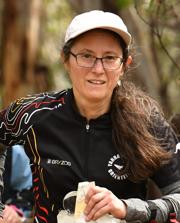
This editorial is about the efficiency and logistics of producing the magazine and making the digital copies easily accessible. Editor’s work has increased with the introduction of new policies.The Orienteering Australia Photography Policy is in line with the Orienteering Australia Safeguarding Children and Young People Policy, and these policies are based on the National Integrity Framework that 80 sports in Australia have signed up to.We all have to adhere to them, every club, member, orienteering media producer, and official.There are also copyright laws protecting economic and moral rights of authors, which need to be followed. Please:
1. When submitting an article, send only items you have permission to publish, this includes photos of minors, maps and translations of articles. Any photographs should have information about the photographer: their name or ‘photo was taken by a passerby’.
2. Remember that items in The Australian Orienteer cannot be republished without a permission. It is easiest to just provide links to the articles. Alternatively, you can ask the permission of writers to republish their text, of photographers to include their photos, of parents of minors to have their children’s photos or photos with names included, and of copyright holders of maps to publish fragments of their maps.
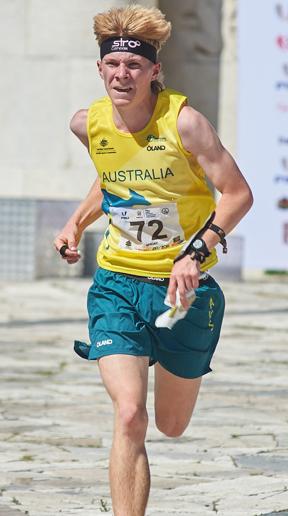
3. When organising a major event, ask for parental /guardian permission to photograph minors and include separate checkboxes for social media, for The Australian Orienteer, for Orienteering Australia eNews, for orienteering organisations’ websites, and include a comments’ section, so people can select the options that suit them. Don’t link permission to be photographed with the right of entry, those who don’t want to be photographed should still be able to participate.
4. If you are a photographer who is happy for your photos that you have posted on a website or social media to be published elsewhere (in this magazine, club newsletters, etc) please include the text that lets us know this, and how you would like the copyright to be attributed.
5. When you have an idea for an interview, you are welcome to think of the questions, ask them and to write the article. It isn’t the editor’s role to extract something useful from an audio file.
6. Run your idea of an article past the editor as early as possible. I have introduced a deadline for ideas to help with this.
7. Adhere to the deadlines for submissions but if there is something to include urgently, make it short, so it is less challenging to insert.The deadlines for the next issue are in the dark-green box on page 5 of each given issue.
8. Make the digital copies of the magazine on ISSUU as accessible as possible, share the link to the magazine’s page on the Orienteering Australia website or directly to the magazine’s site on ISSUU. Inform new orienteers about their magazine. Have a hard copy on display at events.
Thank you to everyone who already does this.

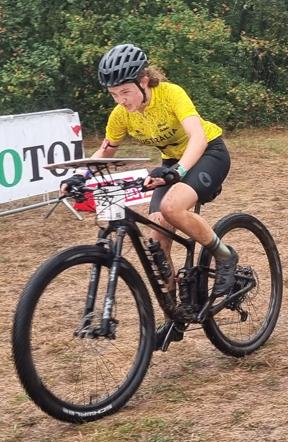








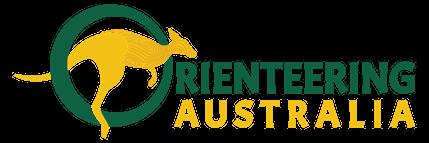
ORIENTEERING AUSTRALIA BOARD
Chair & Director – International (IOF)
Director – Finance
PO Box 3379, North Strathfield, NSW 2137
MikeDowling
PaulLiggins
Director – Technical AnnaSheldon
Director – IOF Foot O Commissioner
Director Coaching & High Performance
Director Media & Communications
Director – Ex Officio
BrettWeihart
ClareHawthorne
TroydeHaas
BlairTrewin
Director AndreaHarris
Secretary RobertSpry
ORIENTEERING AUSTRALIA
AND OFFICERS
General Manager ÁrpádKocsik
Head Coach NatashaKey
Manager of High Performance & IOF Map Commissioner
Manager of Coaching Development
Participation Manager
Manager of Coaching & Officiating Administration
FredrikJohansson
BrodieNankervis
DanielStott
JimMackay
National Sporting Schools Coordinator JimMackay
Chief Medical Officer
Editor OA Enews
MarkFreeman
LindaBurridge
Badge Scheme Secretary JohnOliver
Eventor Project Manager
Manager of Integrity and Complaints
MTBO Development Officer
Communications & Marketing Manager
PaulPrudhoe
AndrewShipton
CraigSteffens
LizLeung







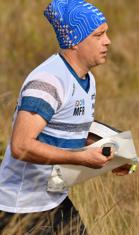


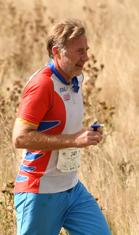



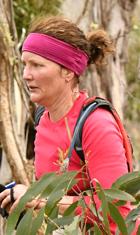











Orienteering Queensland: POBox275,FernyHillsDC,QLD4055.Secretary:SueCampbell secretary@oq.asn.au Orienteering NSW: POBox3379NorthStrathfieldNSW2137.Secretary:GayleQuantock secretary@onsw.asn.au Orienteering ACT: POBox402JamisonCentreACT2614.Secretary:StephenGoggs office@act.orienteering.asn.au Orienteering Victoria: POBox1010TemplestoweVIC3106.Secretary:AislinnPrendergast secretary@vicorienteering.asn.au Orienteering SA: 1 Windsor Rd, Glenside SA 5065. Secretary: Fi Pahor secretary@sa.orienteering.asn.au Orienteering Western Australia: POBox234SubiacoWA6904.Secretary:CeriPass oawa.secretary@gmail.com
Orienteering Tasmania: Secretary:KlaasHartmann secretary@tasorienteering.asn.au
ISSN 0818-6510 Issue 4/24 (no. 214) DECEMBER 2024
The national magazine of Orienteering Australia Inc. ABN 77 406 995 497 Published four times a year: 1 March, June, September, December. Copies are dispatched in bulk to state associations in the week prior to that date. Print Post Approved PP 236080/00011, (100023602 for NSW).
Editor: Hania Lada, P.O. Box 200, Ringwood East, Victoria 3135 magazine@orienteering.asn.au Phone 0493 615 203
Magazine Design & Assembly: Peter Cusworth, Phone 0409 797 023 pcusworth53@gmail.com, and Hania Lada
Printer: Razer Graphix, Factory 6/15 Stud Road, Bayswater.
Contributions welcome! Prior consultation is suggested before preparing major contributions. Guidelines available from the editor and the website https://orienteering.asn.au/index.php/magazine/ Orienteering Australia website > magazine
Regular Contributors: History & Awards – David Hogg; Competition –Blair Trewin
Subscriptions: State Association members via State Associations. Contact relevant Association Secretary for details. Other subscribers: For information about payment refer to the Orienteering Australia website https://orienteering.asn.au/index.php/magazine/ Orienteering Australia website > magazine or contact the editor.
Opinions expressed in The Australian Orienteer are not necessarily those of Orienteering Australia.





Top End Orienteers (Northern Territory): POBox39152WinnellieNT0821.Secretary:SusanneCasanova topendorienteersNT@gmail.com


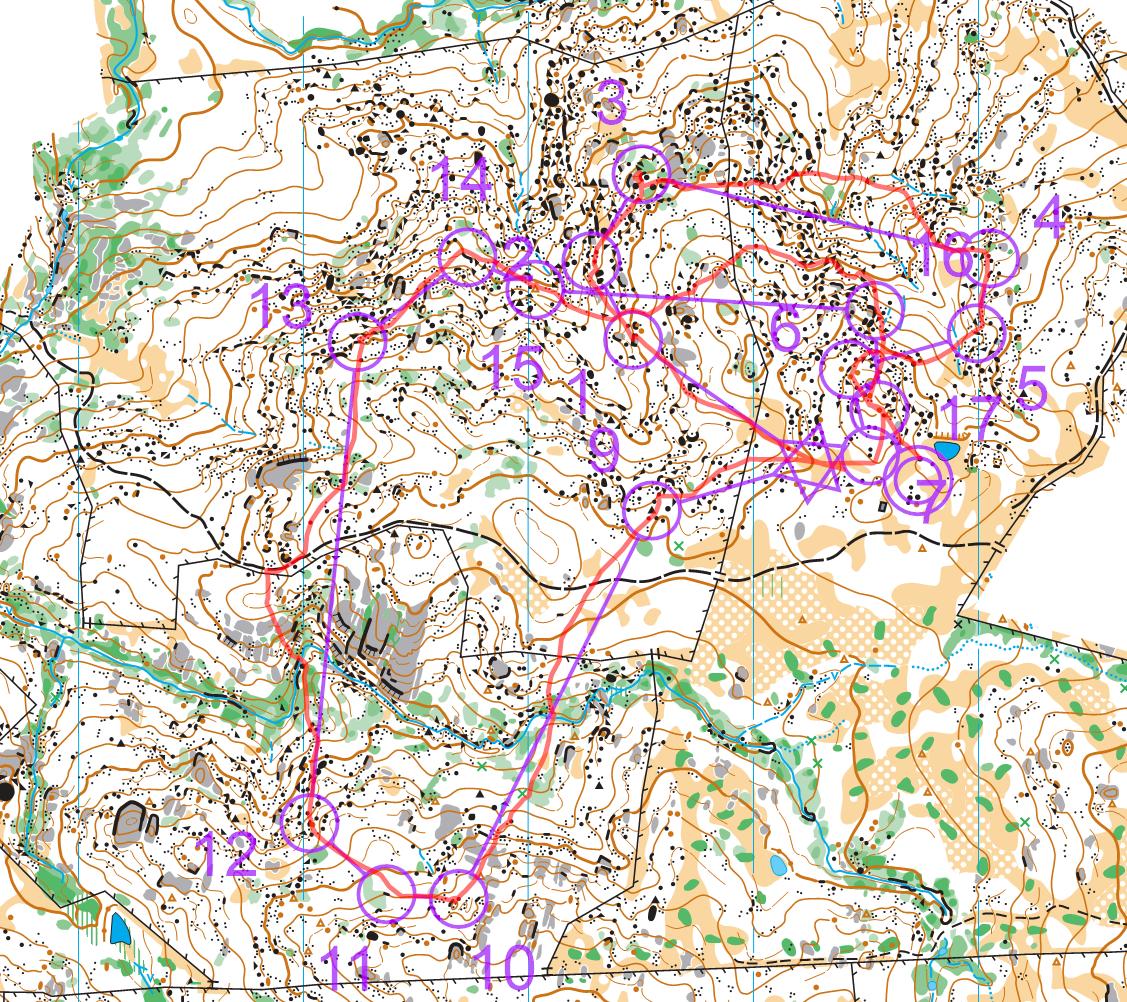

In 2024 the Australian Championships week came to Armidale. It was the first time a major national carnival has come to that part of the world, but those who had been before knew the local terrain was excellent and that it was long overdue for the rest of the Australian orienteering community to get their chance to run it. The area for the three forest championship events was particularly enjoyable, over 20 km² of mostly runnable forest with lots and lots of rock, and a suitable place for a central arena for all three events too, which made the logistics a lot easier.The conditions were mostly kind, with no repeat of last year’s Long Championships heat.
As usual, there was a substantial New Zealand contingent, and a few other internationals too. Only one of the six senior elite titles on offer went outright to an Australian, with New Zealanders taking three (although some of those who would have been local contenders were still in Europe contesting the final World Cup round).
The week started on the western corner of Glenburnie, one of the more detailed and steeper parts of the map, and well suited for middle distance courses.The technical courses saw many of the most skilled orienteers come to the fore, and there were some big margins for relatively short races. Outside of M10 (a dead-heat between Maxwell Povah and Benji White) and W10, there were only four classes decided by less than a minute, and eight decided by more than five.
One of those four close classes was M21E, where 90 s separated the top four, who all had fairly consistent runs. New Zealander Felix Hunt took the lead at the second control and held it for the rest of the race, but it was always a close-run thing, with the gap never getting out beyond 36 s. It was enough to take the win though, 29 s ahead of the evergreen Julian Dent in the most impressive result yet of his return to Australian competition. Matt







Doyle, not sighted very often in recent years, made a welcome return and ran the fastest second half of the course, but a 90-s deficit in mid-course was too much to bridge and he had to settle for third.
Many of the women fell at the first hurdle, with several big names losing multiple minutes at the opening control and disappearing from contention, including favourite and National O League winner Grace Crane.Two who managed to negotiate that without too much trouble were Renee Beveridge and Mikayla Cooper, and although both made some small mistakes, they remained clear of the field for the rest of the race, with Beveridge making it an NZ double. Mikaela Gray, still a junior, recovered from early lost time and came through for an impressive third.
The locals held sway in the top junior classes, with comfortable wins for top-ranked runners Nea Shingler and Sam Woolford. Shingler dominated from the third control onwards and a small mistake on the second-last made little difference, with Justine Hobson the only opponent to get within 7 min of her. Woolford also set up an early lead that was never challenged, but there was a more interesting contest for the minor placings; Alvin Craig and Owen Radajewski both lost time when in medal positions, opening the way for steadier runs by Jake McLellan (NZ) and Jamie Woolford to fill the places.
One of the closest of the older classes was M50, where 50 s covered Bruce Arthur, Craig Dufty, Grant Bluett and Carsten Joergensen (NZ) in a deep field. Bluett made a fast start but 90 s lost at #9 brought him back to the field; Arthur was fourth at that point but a strong finish brought him home in front.Tony Woolford survived a late 1-min mistake to hold off Ian Prosser and Greg Barbour by 31 s in M60, while a similar scenario unfolded in W45 where Sara Prince (NZ) had 25 s in reserve over Marina Iskhakova after leading most of the way.There were some big margins elsewhere with Aaron Prince (M45), Debbie Davey (W65) and Jenny Bourne
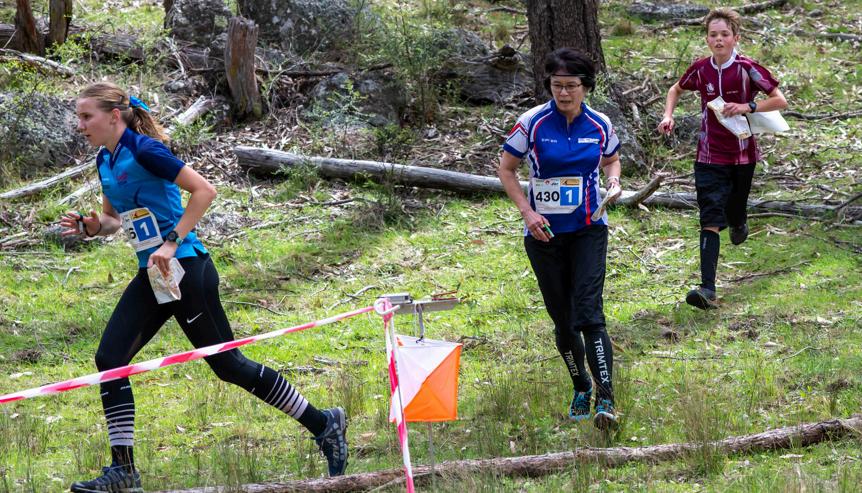






(W70) among those to win by 5 min or more in relatively large classes, although not all those classes were as straightforward as their final results made them look; Prince was trailing Martin Dent until the Canberran made a large mistake at #11.
The junior classes saw some impressive breakthrough results, as they often do at this point in the year. Matthew Layton took the first major title of his career after a consistent run in M16 (even more consistent was Alex Vanzella, who came second despite not being in the top four on any splits), while Ariadna Iskhakova brought her sprint form to the forest, coming from behind to overtake the New Zealand pair of Anna Wright and Greta Prince. Ella Clauson, impressive in W12 last year, was even more impressive on moving to the next age group, putting 6 min between herself and the rest of the W14 field.
As they did last year, the Australian Relays completed the first weekend of the championships, in a generally faster part of the area than had been used the day before, which made for close competition – none of the four elite grades were decided by more than 3 min, and relatively fast running times.
Amongst the closest of all was M21, which looked a very open race beforehand, with several teams missing potentially key runners. It lived up to that expectation with Paul de Jongh (ACT) leading five within just over a minute on the first leg. Blake Reinbott and Toby Lang, neither of whom had been top-six the day before, exceeded expectations to put their teams ahead of the pack on the second leg, setting up a head-to-head battle between Queensland and the ACT on the final leg. It came down to a sprint finish between Ryan Gray and David Stocks, in which the northerners prevailed by 6 s.


W21 didn’t come down to a sprint finish but was still close enough for the win to be in doubt until late. Shannon Jones and Renee Beveridge broke away on the first leg to put the ACT and New Zealand 3 min clear of the field, then Justine Hobson edged away from Amelia Horne on the second leg, giving Grace Crane a narrow lead which she was able to successfully defend. Victoria and Tasmania fought a close battle for third for two legs, before Natasha Key (VIC) broke away on the last.
Both M20 and W20 came down to races between NSW and New Zealand, finishing one apiece.The NSW women front-loaded their team and built up a double-digit lead through Nea Shingler and Erika Enderby, which gave Mikayla Enderby a big enough buffer to narrowly hold off a fast-finishing Tide Fa’avae. In contrast M20 started with a big pack with nine within 3 min on the opening leg. This was whittled down to three contenders, NSW and two New Zealand teams, on the second leg, then Jake McLellan ran the fastest leg of the day to overrun Sam Woolford.
The younger junior classes provided two of the closest finishes of the day. Oliver Bishop (ACT) held off Zach Meads (NZ) by 4 s in M16, while it was even closer in M/W12 where Patrick Maundrell overcame a 4-min deficit to bring the ACT home by 2 s over Western Australia. While they fell just short in M16, New Zealand had more success in W14 and W16, which they won by large margins from Tasmania and Queensland respectively.
Many of the older classes also had large margins, but there were a few major last-leg turnarounds. Jenny Bourne came through from 3 min back to take the ACT to victory in W55, with second-leg leaders Queensland dropping to fourth, while in M75 Alex Tarr and Tony Radford gave Victoria a 10-min lead after two legs, but New Zealand and NSW overtook them on the last with Rob Garden giving NZ the points by a minute over Steve Flick.

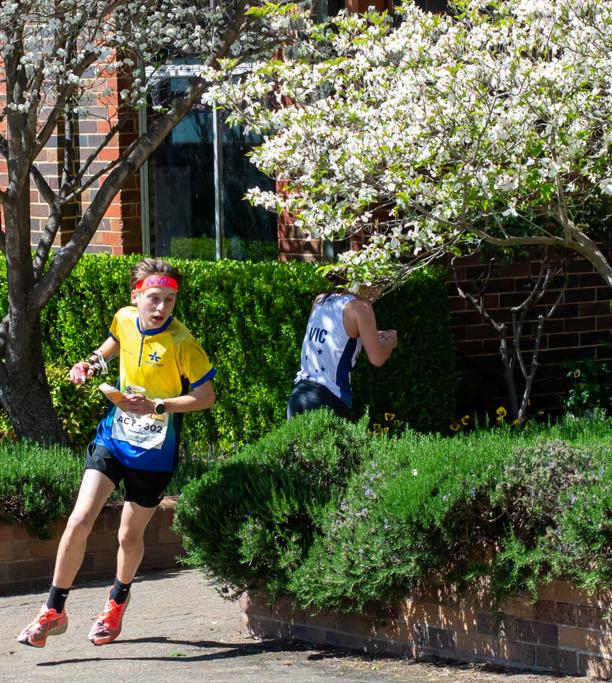








Outwardly, the Australian Schools Championships were situation normal. New South Wales was the champion state for the fourth time in a row, Queensland and ACT had a close battle for second (with Queensland prevailing this time), and the two New Zealand teams were ahead of all the states, with Karahiwi two points ahead this time.
It was not as straightforward as that looked, and before what turned out to be a rather chaotic relay, the New Zealand teams faced their closest challenge for years, and New South Wales had a useful lead but not an insurmountable one. As it turned out, New Zealand swept the relays, with two wins for Karahiwi, one for Harua, and the two unable to be separated at the end of the junior boys.The last result would have made the junior boys relay interesting enough in its own right, but it was memorable for plenty of other reasons; two teams mispunched on the first leg, one on the second, and two more on the third.The disqualification of ACT for taking the wrong map on the last leg left Victoria as the only one of the seven state teams still standing; they somewhat unexpectedly led after two legs through Matthew Layton and Xander Greenhalgh, but were overrun by the New Zealand pair of Zach Meads and Evan Rees-Jones on the last.




As they had all week, New South Wales dominated the two senior classes, being easily the best of the state teams and coming second overall in each against strong Kiwi opposition. In the senior boys only 39 s separated the three leading teams. Jake McLellan brought Karahiwi back from 6 min down on the first leg to send Oscar Burns out in the lead; Jamie Woolford almost ran down a 4-min gap on the last and fell just short of the win, although he did outsprint Eddie Swain for second.The senior girls was more straightforward with Juliet Freeman giving Harua an overwhelming lead on the second leg after a close first, although Erika Enderby ran the fastest leg of the day to cut a bit into the final margin.
With none of the three leading states taking any points from the junior boys, another strong NSW class, the possibility was just about open for Queensland to come through.Their junior girls needed to beat NSW by three places to tie overall, which looked possible on paper given the long distance results, but NSW had their best day of the week, thanks mainly to an excellent lead-off leg by Stephanie Dun, and came through for third – just ahead of Queensland – to secure the title by four points.
The relays were preceded by well-contested individual competitions, with none of the sprint winners able to repeat in the long.The sprint took place at the Armidale School, a complex campus with





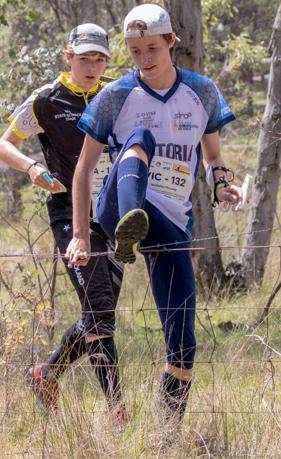

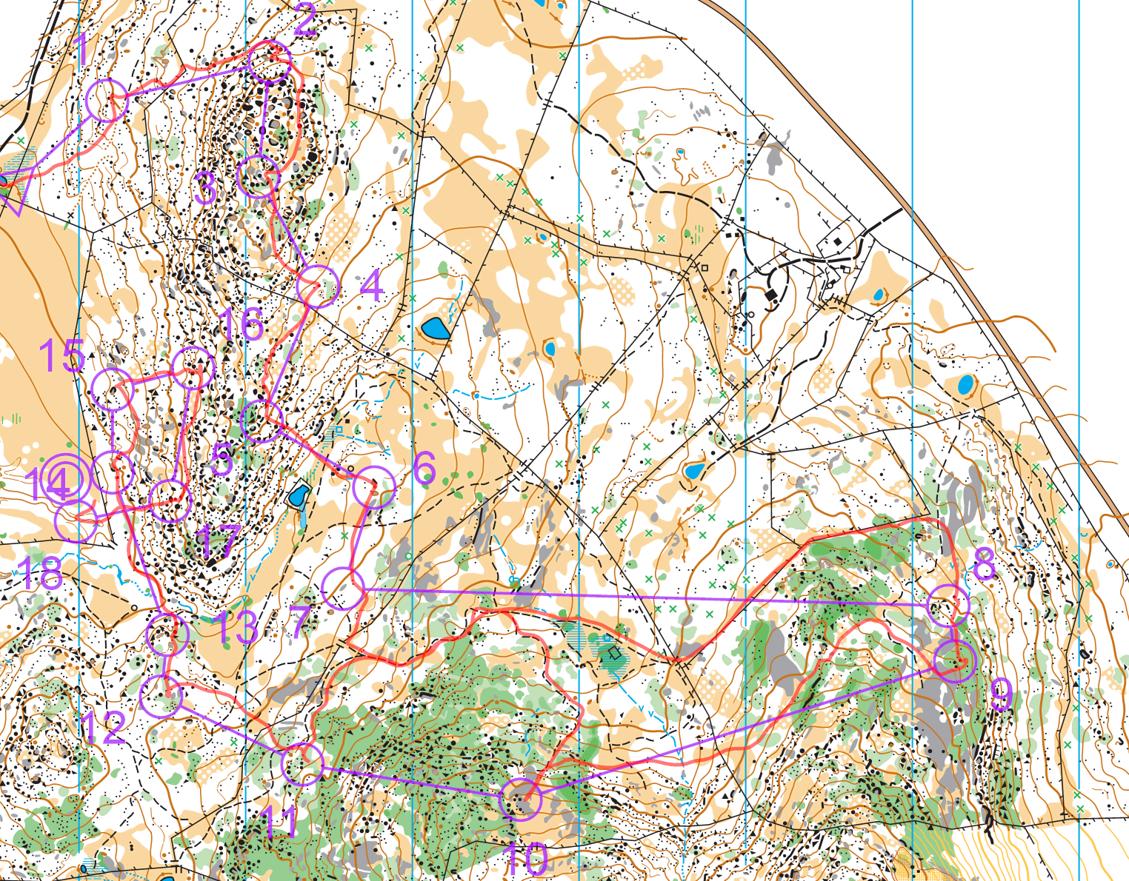










plenty of route choice options, and some well-credentialled participants, with Cooper Horley, Erika Enderby and Milla Key all having represented Australia at WOC. Horley went in as a clear favourite in the senior boys and duly prevailed over Euan Best by 24 s, but in the senior girls the New Zealanders upstaged their Australian competitors. Anna Babington edged out Key after the Victorian had small time losses each time she looked like getting into the lead, while Enderby slipped to fourth after taking an early lead, with Georgia Lindroos completing the medals.
Ariadna Iskhakova had been the leading Australian in the 2023 sprint, but this time she took the next step and won outright, leading almost all the way and having 17 s in hand in the end. New Zealanders took three of the next four places, with Sophie Herde coming through to second after a slow start which left her 26 s down at #6.Tasmanian Ella Clauson, still a first-year W14, impressed with a third place, just ahead of Greta Prince who lost her chance of defending her title with two mistakes in the first seven controls. Zach Meads, noted as a sprint specialist in New Zealand, demonstrated that with a 16-s win; Hayden Dent was ninth at #7 and gradually got back into the race but had left himself too much to do.There was some controversy when a number of competitors ran through a gate which was closed on the





map and open on the ground and were disqualified, although no potential medallists were affected.
For the long (and relay) it was a trip to the granite of Pine Tree west of Armidale, a physically tougher area than the weekend, which featured a major route-choice leg involving green. As with the sprint event, the junior girls saw someone make the step from lead Australian last year to outright winner this year; this time it was Katie Clauson, who this time finished ahead of her younger sister (who got her second bronze medal of the week) after a consistent run, making sure of it by being clean at #11 when none of the other leaders were. Defending champion Anna Wright led for the first two-thirds of the course but dropped to sixth over the closing stages, leaving her fellow New Zealander Greta Prince to take second, while Sophie Hartmann’s fifth meant the three lead Australians were all Tasmanians.The junior boys winning time this year was half what it was last year but the result was the same –Alton Freeman, after losing time at #1, was in front by #3 and never troubled thereafter. His closest challenger was his NSW teammate Rory Shedden, who got ahead of Matty Maundrell late in the course.
The closest result of the day was in the senior girls, which ended up as a battle between Tide Fa’avae from New Zealand and the two

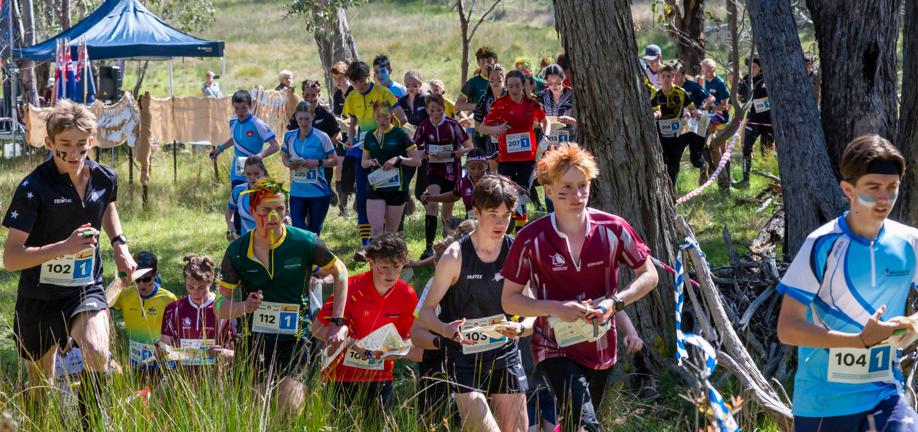


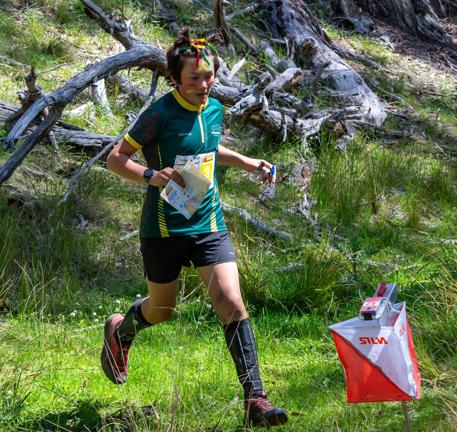
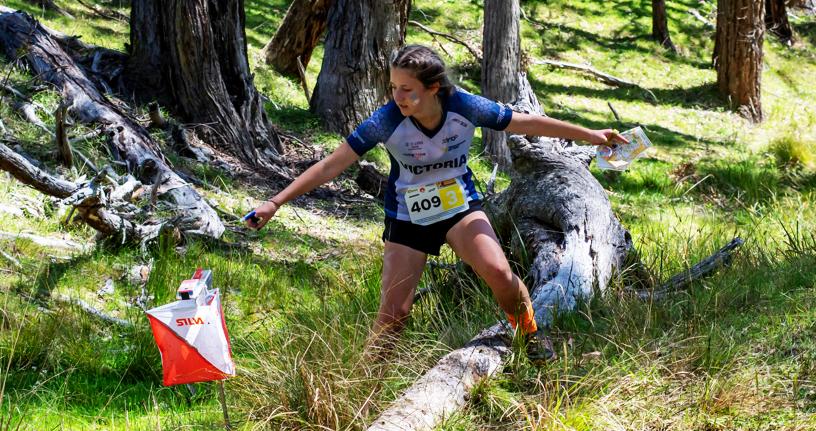

Australian WOC runners. Erika Enderby and Milla Key shared the lead through much of the course after Fa’avae had lost 3 min at #1. Key dropped back when she lost 3 min at #7, and when Enderby dropped 90 s at #10 her lead was down to 41 s.That was close enough for Fa’avae to run her down over the closing stages, taking the lead for the first time at the second-last control and winning the title by 4 s. Key was another 2 min back in third. Senior boys winner Owen Radajewski got a break on the field early, and although others challenged him at times, he stretched his lead out by a minute on the long #10 and ended up 3 min clear of the field. Euan Best repeated his second from the previous day, while a consistent run from Alex Woolford saw him in the medals, after Sam Carryer had injured an ankle badly when in third.
The long distance took everyone to the east side of Glenburnie, with the longest courses also getting out to big hills in the north. The mix of open areas and rocky, sometimes green bush meant a wider range of route-choice legs than on the earlier days, as would be expected for a long distance event, and conditions warmer than those earlier in the week meant it was more of a physical test.

As in the middle distance, both senior elite wins were taken by international visitors. Although her best international results have been in the sprint, Hanne Hilo, arriving to be a visiting coach in South Australia, has represented Finland at World Cup level in forest races too, and was always likely to be a formidable opponent for the locals. She led all the way, and had opened up a 3-min gap on Grace Crane by #6 which then remained fairly stable for the rest of the way. Crane, who has dominated the long distance in Australia in recent years, was the only Australian in the top four (and 14 min clear of the next best Australian). A consistent run from Kaia Joergensen, just returned from the World Cup, saw her take third over fellow New Zealander Briana Steven.
Felix Hunt made it two wins from two championship races in M21E, with his closest opponent this time being his teammate (and JWOC long silver medallist) Zefa Fa’avae. Fa’avae led through the early controls but lost 2 min at #8, giving Hunt a lead he never relinquished. Julian Dent was second at #10 but drifted back through the later part of the course, opening the way for David Stocks to claim the resident title in his first year as a senior.
M20 was a close and fluctuating race in which five were within 3 min of the lead. Cooper Horley has made his recent reputation in


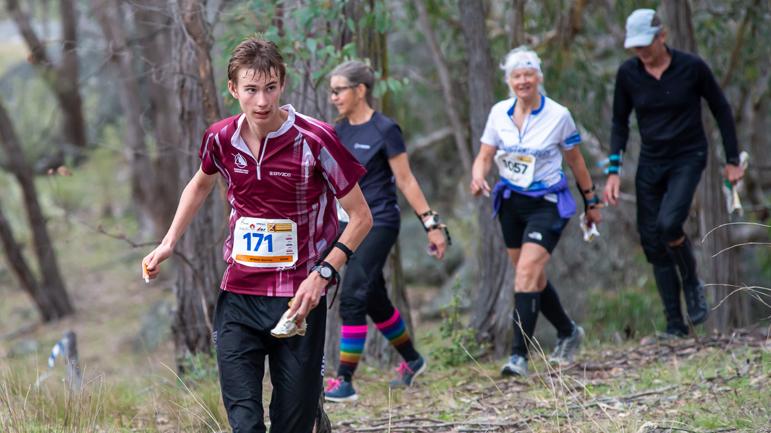







the sprint, and at #6 he was in sixth place (although only just over 2 min down), but from there he made his way through the field, taking the lead for the first time on the last long leg about 10 min from the end. Sam Woolford was still well in contention at that stage, but lost time exiting the second-last control and ended up dropping to third just behind Owen Radajewski, who continued an excellent week.
W20 also saw lead changes in a duel between the NSW pair of Nea Shingler and Erika Enderby. Shingler was the faster of the two, but had to come from behind after losing time at #7, emerging just over a minute clear in the end. A strong finish from Justine Hobson gave her her second medal of the week.
The middle distance may have been somewhat lacking in close finishes but the long made up for it. Nine classes were decided by less than a minute, and three of them by less than 5 s, while only two were won by more than 6 min.Two of those classes were at the older end of the spectrum. W70 brought together three significant figures of Australian elite orienteering of the 1980s and early 1990s, Jenny Bourne, Louise Fairfax and Sue Key, and although Bourne had won easily the previous weekend, it was a different story here,
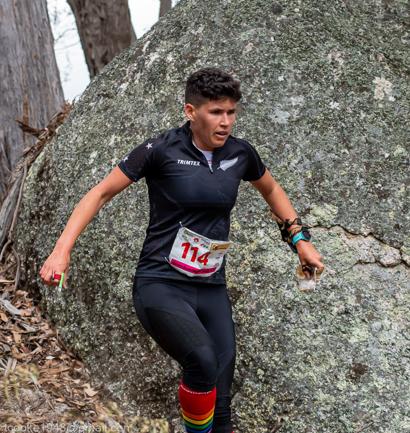




with Fairfax pressing her all the way but missing out by a bare 2 s. The margin in the oldest age group, M85, was only one second larger, with Basil Baldwin edging out John Hodsdon (and Janet Morris’s margin in W85 was under a minute too). In M14 it came down to the finish chute, with Rory Shedden’s faster sprint enough to get home by 2 s against Hayden Dent.
Natasha Key might have been expected to dominate W50, but early mistakes left her 4 min down at one stage, and it took an exceptional long uphill #13 – winning the split by nearly 3 min – to get her back into a position to edge out Clare Hawthorne by 31 s. M75 was also a close contest, with the race between Dave Middleton and Paul Hoopmann not decided until the last control; there were five within 2:15 of the lead, plus Ross Brighouse who mispunched at the second-last when in the lead. Like Jenny Bourne (and Debbie Davey in W65), Ella Clauson followed a big win one weekend with a small one the next, taking W14 by 13 s over Jemma Hoskin after a close race most of the way, while Greta Prince’s 33-s win over Anna Wright led a New Zealand sweep of the top four in W16.
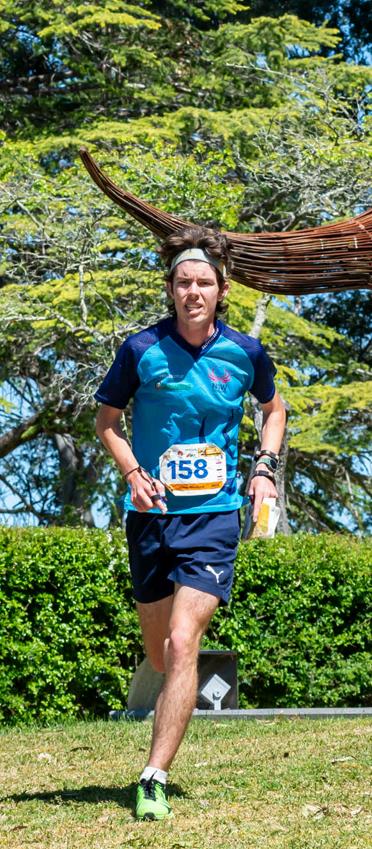







The week finished with the sprint at the University of New England.This offered most of the challenges that a campus sprint usually offers, and more of a slope than some campuses do (although it wasn’t really a factor in route choice). Not everyone was at their sharpest after a long day the day before, but plenty showed us what speed they have.
Up until this point the senior elite classes had had overseas winners, but this was the day that changed, through a breakthrough result for the young South Australian Ethan Penck. He had had a decent set of sprint performances so far in 2024, with two NOL second places (and four top-fives), but this was a step to a new level. He was in the lead by #8 and from that point stretched it with almost every control, taking the margin to a commanding 45 s by the end. It was much closer behind that, Patrick Jaffe taking second by 1 s after Felix Hunt’s hopes of a clean sweep ended with 30 s lost at #2. Ewan Shingler looked to have tied with Jaffe for second, but missed a control.
After her win the previous day, Hanne Hilo was a clear favourite in her favoured distance – she has a fourth in a JWOC sprint to her name – and lived up to that expectation. Mikayla Cooper led through the first ten controls, but the Finn took command over the second half of the course, winning eight of the last nine splits and extending her margin to over a minute. Kaia Joergensen also had a good second half and overhauled Cooper, who had to settle for third. It was still a good week for the Tasmanian, who took her second resident title of the week.
A lot of the Australian female sprint talent is found in the juniors, and that was demonstrated here. Nea Shingler produced a dominant performance, winning 18 of 23 splits and running a faster time on the same course than Hilo had done. Behind her Milla Key and Zoe Carter – on the comeback trail from a serious ankle injury at JWOC – were duelling for second for part of the course, before a mistake from the South Australian saw her drop out of the medals. Cooper Horley, having won the previous day at his less favoured distance, repeated the result at his most favoured,

and beat the times of all the seniors except Penck; Sam Woolford pushed him most of the way and led at times in the middle, but in the end fell 11 s short.
The junior men provided most of the closest results. Having lost to him by 2 s the previous day, Hayden Dent turned the tables on Rory Shedden with a 3-s win in M14, while his older brother Elye, who has been focused on running for most of the year, prevailed in M16 after a duel with Miles Bryant where the two were never more than 8 s apart. Finn van Keulen also had a single-digit winning margin in M18. It was a different story for the girls, with the New Zealand pair of Sophie Herde and Zara Toes having comfortable wins in W14 and W16 respectively.
The closest masters finish was in the oldest class, with the two W85 competitors, Janet Morris and Helen Alexander, separated by only 5 s. M65 was almost as close; Tim Hatley gave Geoff Lawford his closest challenge of the week, but Lawford completed the clean sweep with 6 s to spare. M75 had a dramatic late twist when both Paul Hoopmann and Rob Garden lost time at the third-last to leave Tony Radford with the win, while in M60 Greg Barbour and Tony Woolford were both off the pace early but came through to take first and second.
Kathie Dent in W45 was another to recover from a slow start, taking her first title with a fast finish after being over a minute down at #5, while two NSW competitors with a reputation for speed, Barbara Hill and Paula Shingler, took out W55 and W60 respectively, and Gareth Candy made a welcome return to national competition, ending Aaron Prince’s bid for a sweep in M45. Among others who did make it three out of three, with varying degrees of comfort, were Matt Crane (M40), Bruce Arthur (M50), Eric Morris (M55),Ted van Geldermalsen (M70), Alex Tarr (M80), Jenny Bourne (W70) and Judi Herkes (W80).
Those who knew how good the Armidale terrain was got what they expected, and those who didn’t found out why it was worth the trip. Next year we will be not too far away, in the Brisbane region, although with quite a different mix of terrain.

Senior girls: Erika Enderby (NSW), Liana Stubbs (Tas), Xanthe Schubert (Qld), Rebecca Craig (NSW).
Senior boys: Cooper Horley (NSW), Owen Radajewski (ACT), Euan Best (Tas) Miles Bryant (Qld).
Junior girls: Ariadna Iskhakova (ACT), Sophie Hartmann (Tas), Ella Clauson (Tas), Katie Clauson (Tas).
Junior boys: Matthew Layton (Vic), Matty Maundrell (ACT), Alton Freeman (NSW), Adrian Garbellini (Qld).

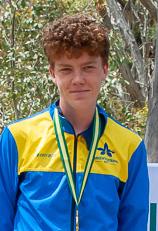
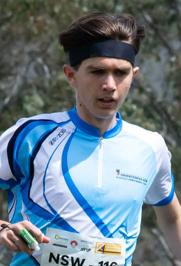


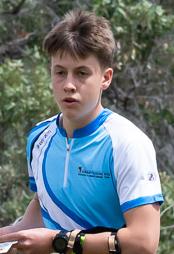
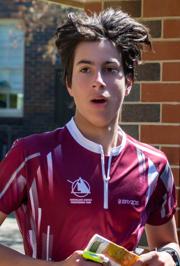
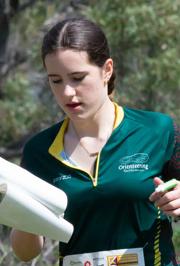


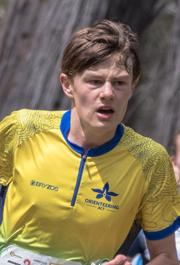

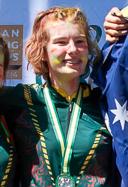
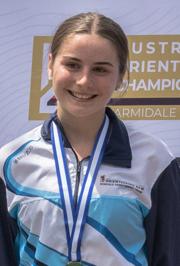


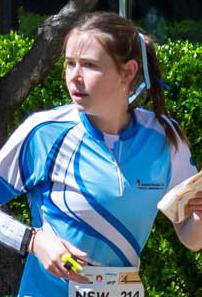


KAY HAARSMA, WMTBOC TEAM MANAGER



Our small team of three riders and two accompanying parents, Mel Kent and Gavin Bennette, met in the capital of Bulgaria, Sofia (population 1.3 million) before spending nine days zigzagging the 500+ km to the event centre of Shumen (population 90,000). We stayed along the way at Kazanluk and Veliko Tarnovo (population 70-90,000) to do some training in the local areas.
Sofia certainly was interesting to look around. Many monolithic communist buildings built in the 1950s, Roman ruins, and pretty cathedrals and mosques. A number of statues of Soviet figures like Lenin had or were being replaced by more peaceful symbols. Very modern in the city centre but not far from the airport there were very impoverished areas.
We hired a Cargo van and a small Renault car. Fitting five bikes and boxes plus luggage into the van required Tetris-like skills, which Gavin and Will mastered.The highways were good, though the 140 k/h speed limit and aggressive driving of the locals were scary.The smaller roads were very potholed. One lunchtime I fell into the tourist trap of parking too close to a pedestrian crossing and the car got uplifted and removed by a truck carrying a crane! $50 later we had it bailed out!
No official training is provided in the lead-up and it was a bit of a nightmare getting training sorted and even then the two-day event we had entered on the last weekend got cancelled five days out!! Ultimately, we had an excellent training week, often starting in small rural villages (population 700-900) where horses drawing carts still roamed the streets.The highlight was two days training with the Bulgarian team, where we did four excellent exercises in
nice terrains. One of the major technical differences we were training for was considering off-track riding in route choices as ‘cutting’ through the forest was allowed.
For the championships we stayed in the Shumen Grand Hotel, which was also the event centre, thus making it easy to get to daily meetings. More modest than grand! Quite a few other teams were also there, and we availed ourselves of the surprisingly good hotel buffet for dinner.Throughout the Bulgarian towns coffee-vending machines were everywhere, and some of our team became devotees of 70c-per-cup coffee.
Sprint. The opening event, was held in the rural village of Pliska. Exactly like we had been training on but with the addition of two artificial barriers, which was the first time these had been used in MTBO. Great debut from Maya in her very first international race for fourth, just 1 s off the bronze. She was a late starter and was sitting in third until the last starter dropped her down the rankings. Lucas had a consistent ride and was very happy with his navigation for 31st. Despite car traffic supposedly being ‘restricted’Will had the misfortune to be stopped and rerouted by a policeman directing two big trucks, and ended up 57th.
The other four events were held on the forested Shumen Plateau, which had excellent terrain, but had riders crisscrossing the same area, which seemed less than ideal for a world champs. Maps and courses were very good.
Mass start saw riders having to cope not only with both wet and muddy conditions but also four controls requiring manual punching, one of which was the elite spectator control. Maya placed a good 14th despite an over-the-handlebars crash early on. Lucas was 36th, and again finished quite pleased with his navigation. Will came 55th, quite disappointed with his navigation although hampered by wearing glasses in the rain.





Middle. Not so good news. Maya spent the night vomiting and struggled to turn the pedals too hard finishing 24th. Commendable even being able to do that. Will got stomach issues mid race and also got stung by a wasp to struggle to 57th. Lucas didn't navigate so well today, having issues on 1 and 2, and then found his legs physically didn't have much to give, he was 36th. I got a chance to ride the women's course afterwards, it was fantastic terrain.
Long. The start was at the bottom of the plateau with a daunting initial big climb up. Elite men had 37 km with 990-m climb. Success can be measured in many ways as demonstrated by our three riders. Will led the way, finishing 48th, but having a pleasing ride given that his percentage behind the winner was quite good. Maya was still riding with little food intake or energy, and was in survival mode again, finishing 22nd. Lucas had an eventful ride, breaking his chain and not having a quick link, he just shortened his chain, first time fixing one and no Mr Google to consult! Lost lots of time but was determined to finish, and he placed 39th.
Relay. Our elite men’s relay team consisted of one elite and two 16-year-old juniors. Will led off and had both navigation issues and a fork problem so that left us well off the pace, 73:18. Lucas showed great composure to cope with the wait and then ride well, doing a very respectable 59:33. Maya went out to a lonely forest and then had to cope with rain. She was feeling healthy again, but legs were still depleted. A few small mistakes to record 71:31, and 14th official nation.
Overall, we were rapt to ride with no mispunches all week, and for all to finish every race despite the illness and mechanical issues. A bit of ‘what could have been’ but all experienced great terrain and know what world champs are all about now. Our two juniors were only 16 years of age in the MW20 competition. Next year’s championships will be in Poland, on the outskirts of Warsaw.
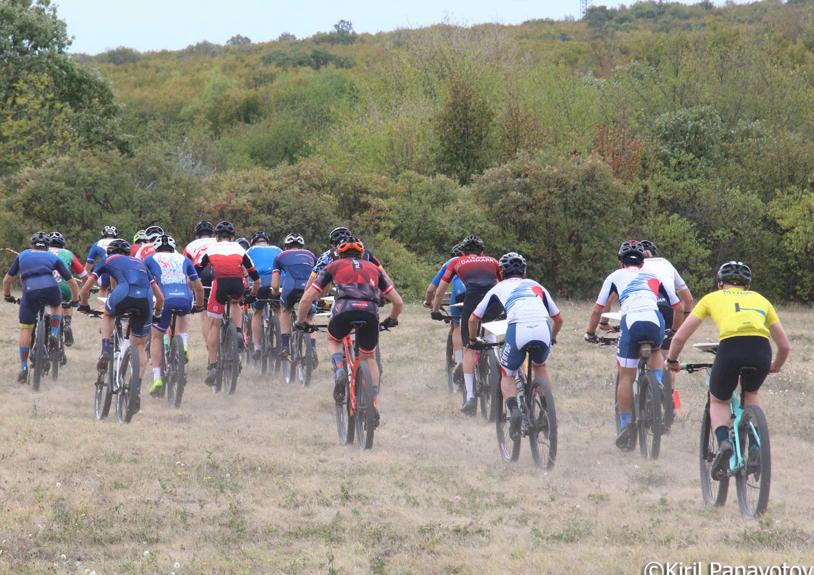

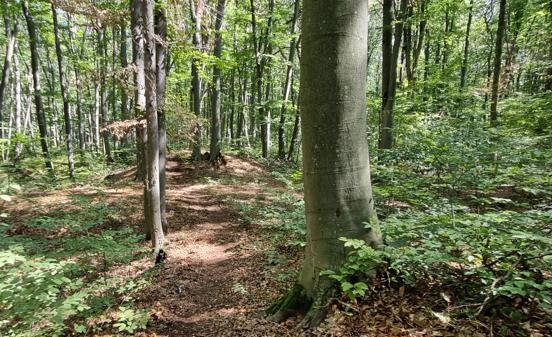
Which was your favourite event and why?
MAYA: My favourite event was the sprint as I really enjoyed the fast course and the constant turns and decision making. I also liked that they used artificial barriers to add to route choice. I really enjoy this type of fast, complex racing. My plan was to start the race a bit slower and ride into the course to finish strong and to make sure I had a clean ride. It worked. (She was fourth)
LUCAS: My favourite was the relay, the last event of WMTBOC. As well as being able to ride as part of the team, I enjoyed the technical course that had longer legs at the beginning of the race, then short and fast legs towards the end, and a spectator control for my first time in the champs.
What advice would you give to junior riders thinking about competing at world champs?
MAYA: I was happy with the preparation I did leading up to the champs but next time I would look in greater detail to the type of terrain we would be riding and do more preparation with indistinct tracks and cutting. Sadly you can‘t prepare for getting gastro. Though MTBO in Europe is quite different both in terms of terrain and the number and size of the events, MTBO is really just about you, your bike and the map, so as long as you prepare as much as you can and adapt, you will be able to get results, you’re really proud of.
LUCAS: Just go for it! Being at the World Championships this year was a rewarding experience in which I got to see a new country that was very different to Australia, met new people from other countries who I will see for years to come in the sport. I experienced my first worldchamps-level sporting event, something not many people are lucky enough to do.
Men WMTBOC 2024 Relay map. Czechia, Finland and Austria won gold, silver and bronze, respectively. Women’s relay medals were won by Denmark, Finland and Switzerland.

My road to Junior World MTBO Champs (JWMTBOC)
My involvement in orienteering combined with my interest and passion for mountain bike riding, inspiring me to take up MTBO. Adding navigation to riding technical tracks creates a challenging yet rewarding experience that I enjoy.
My road to the Junior World MTBO Champs took me through different challenges and experiences that I am grateful for. I’ve raced in NSW, ACT and Queensland over the last year, which provided invaluable experience and opportunity to develop my skills. I also attended the MTBO training camp in Ballarat and learnt from Czech star Veronika Kubinova. This camp pushed my limits physically and mentally with some tough navigation; however, this is where I developed skills and techniques I needed when in Bulgaria. Getting to the world champs would not have been possible without the support of a few key people, namely Marina Iskhakova (ACT), Peta Whitford (Victoria), and Kay Haarsma (SA) who provided invaluable training advice and support. Yarra Valley Orienteers kindly helped me out and my parents get organised, and motivated me.
Training for a world champs (especially for the first time with no clue exactly what you are going into) was not an easy task. Fitting in trainings with my already very busy schedule of other sports, Year 11 studies, and hobbies was the first challenge, with both a detailed weekly timetable and training plan needed. Some days I just didn’t feel like training even though my plan told me I should. Hopping on a bike after school in the cold to beat the sunset in the winter months was hard, however with motivation from parents, and the end goal in sight it was possible.

Equipment, I learnt that equipment could make or break your race, so having your bike and all related equipment working perfectly is critical. I also learnt to be ready for anything. After many punctures in both CX and MTBO races at home I converted to tubeless. I now carry many spares and tools when riding, and this came in useful in the long JWMTBOC race when I snapped a chain and was able to repair it on course. I used the tools also for adjusting my bike throughout the week.


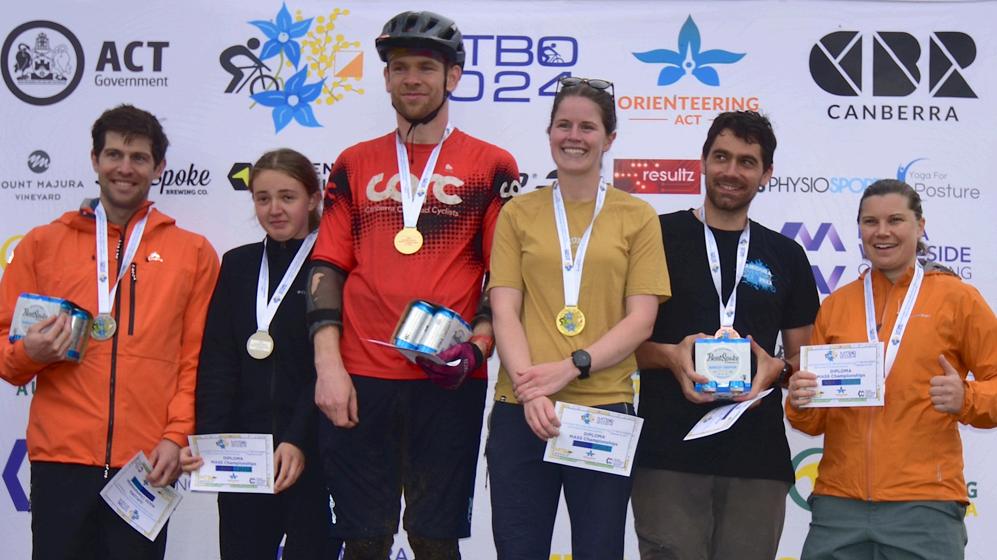
This carnival would not have been possible without Sandor Talas, a world-class MTBO expert who relocated to Australia in 2022. As a member of the MTBO IOF Committee and an IOF Senior Advisor for over ten world cups, world championships, and world masters in MTBO, Sandor brought invaluable expertise. He asked precise, challenging questions, shared his world-class knowledge generously, and conducted two half-day workshops in Canberra for our MTBO course setters and controllers.Thanks to him, our team was able to achieve a high standard of competition.
The vibrant atmosphere of the MTBO carnival in Canberra was made possible by the support of numerous local businesses, partners, and landowners. From the aroma of fresh coffee by KDS, massages by Physio Sport for tired riders, a relaxing yoga session led by Canberra yoga expert and studio owner Elena Amani, local wines from Mt Majura Winery, and transport support from local frameless glass businesses like Active Glass, we owe each of them our sincere thanks!
We aimed to showcase a variety of terrains, ensuring participants experienced the stunning and hilly landscapes of Canberra Nature Parks and the most scenic MTB areas.The carnival format was a multi-day marathon with five distinct stages: a warm-up social event at Bruce Ridge, a mass start at West Stromlo, a technical middle distance at the new MTBO map at Stringybark Hill, a fastpaced sprint at Sutton Road Driving Center, and the challenging final long-distance event at the tranquil Kowen Forest.
The Australian MTBO Carnival hosted the first stage of the 2025 World Masters Series. Series head Keith Dawson (UK), who participated in our carnival, praised MTBO as a unique, inclusive sport that supports mental, cognitive, and emotional well-being, advocating it as a 'magical treatment’ that should be promoted worldwide.
The ANZ MTBO Challenge saw fierce competition between Australia and New Zealand. Australia narrowly lost, 17 to 18, on the last day.The NZ team was in excellent form, showcasing their fitness and readiness as worthy competitors.The most competitive class of the carnival was M60, with 32 participants competing for beautiful medals designed by Noel Schoknecht,WA. Unfortunately, many strong MTBOers left without medals. Detailed results can be found on Eventor
A significant achievement was the full podium in the M80 category and an almost full podium in the W80 category. At the vibrant and beautiful MTBO celebration night, the audience gave a welldeserved round of applause to these courageous riders, proving that age is no barrier in MTBO.
The carnival also introduced ‘carnival classes’ for social, noncompetitive riders prioritising enjoyment over speed. It was wonderful to see so many newcomers trying MTBO for the first time, and we hope participation continues to grow.
The highlight of the carnival was the meshO radio system.Thanks to support from the Moira Whiteside Orienteering Bequest grant by OA, meshO developed a radio network with live commentary, a first for MTBO events.This feature delivered real-time information on riders to screens, creating an electrifying atmosphere as spectators eagerly awaited each rider’s performance commented excellently by carnival commentator Árpád Kocsik, former IOFevents commentator, who brought world-level atmosphere to our carnival.
A special thank you goes to Orienteering ACT for their incredible support.The team of course setters and controllers put in heroic efforts over 12 months, ensuring the top-quality carnival we enjoyed, particularly the mass-start team - Cathy Hogg and Belinda Allison, the middle team - Michael Reed, Emily Walter and Tom Walter, the sprint team - Cath Chalmers and Eoin Rothery, and the long team - Fedor Iskhakov and Marina Iskhakova. Finally, a heartfelt thanks to the team of 60 Orienteering ACT volunteers, who managed countless tasks, from toilet setup and kids' tent supervision to map board installation, start and traffic marshalling, photography, and arena setup in the best possible manner.
Thank you to everyone involved for your dedication in making this MTBO Carnival as memorable and enjoyable as it has been!ACT is scheduled to host the next Australian MTBO Carnival in 2029, so if you missed this one, mark your calendar now. It’s going to be even bigger, brighter, and more fun!
AUSTRALIAN MTBO CHAMPS ELITE RESULTS
MASS START - M21 top three
1 Tomas Krajca
1:04:53 2 Tom Reynolds
1:07:01 3 Timothy Farrant NZ 1:11:26
MIDDLE - M21 top three
SPRINT - M21 top three
MASS
LONG - M21 top three
- W21 top three

TONY HOWES, AUSTRALIA TEAM MANAGER
With New Zealand leading 16 to 10, Australia needed to score at least eight wins in the final long distance event to regain the ANZ Challenge banner.
EVENT 4 LONG: NZ 2, Australia 7
Overall: NZ 18, Australia 17
The large NZ contingent, 41 riders overall, retained the ANZ Challenge banner and have taken it back across the Tasman until the next ANZ Challenge. Will it be in NZ in 2026?


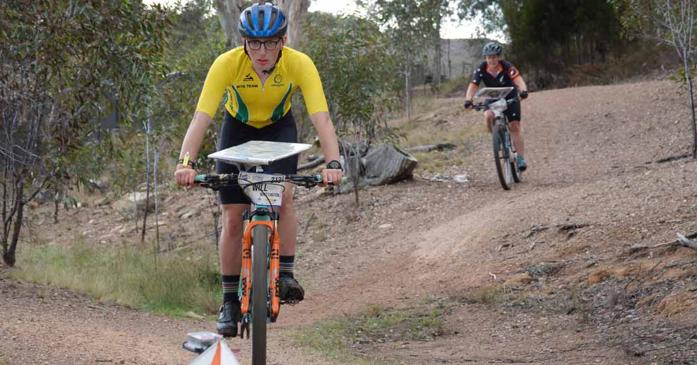
The 2024 Australia-New Zealand (ANZ) Challenge was held during the Australian MTBO Championship carnival in Canberra in October. The away team has the privilege of picking which classes would compete, choosing nine in all (W21, M21, W40, M40, W50, M50, W60, M60 and M70). All four championship events were used in the series, with the combined time of the first two riders from the Australian and New Zealand teams compared in each class with 1 point allocated for each class win.
EVENT 1 MASS START: NZ 5, Australia 3
The W60 class was voided as two NZ riders stopped to provide assistance to a seriously injured rider, and would have lost had their times been used.
EVENT 2 MIDDLE DISTANCE: NZ 6, Australia 3
EVENT 3 SPRINT: NZ 5, Australia 4
Some highlights included the sportsmanship and camaraderie between the two teams, exemplified by the efforts taken by the NZ riders helping an injured Australian rider on the first day. There were sweeps (four wins) by NZ riders in M21 and W40 classes. Finally, the M60 class was tightly contested with a 56-s win by NZ in the sprint, followed by a 2-s win by Australia in the final long event.





MARINA ISKHAKOVA (RED ROOS), EVENT ORGANISER, TEXT AND PHOTOS
It is rare for all elements to come together perfectly, creating an event that flourishes under idyllic conditions.This year's 2024 ACT and NSW Ski-Orienteering Championships in Perisher was one of those moments, where absolutely everything aligned. A week in advance, an abundance of fresh snow arrived in the Snowy Mountains.The weather on the day was perfect, with temperatures ranging between 0 and +3 °C, stunning spring-like sunshine, and firm, excellently groomed tracks. Downhill skiing prices skyrocketed this season atThredbo and Perisher, indicating +147% increase post-COVID-19, resulting in an unexpected surge of skiers who opted for cross-country skiing (which is currently almost free, once you reach Perisher) instead of downhill.
Sam Wilson was the course setter this year. He devoted several winter weekends to designing the courses, carefully exploring the area and identifying the best locations for the controls, challenging participants with the most difficult decisionmaking.
Forty ski-orienteers took part in this season's championships. This was the tenth championship, following Swedish skiorienteering expert Patrik Gunnarsson’s revival of the concept at Perisher in 2014.There were no events in 2020-2021 due to COVID-19.This event remains the only ski-orienteering competition in Australia and one of only two in the southern hemisphere.
Everyone enjoyed a cup of hot chocolate at the finish! The big question was: when is the next one? The next event is scheduled for August 10, 2025, Sunday, the second weekend of Perisher XC week. Mark your calendars and start preparing!
You can find the full results at https://eventor.orienteering.asn.au/ Events/ResultList?eventId=19571&groupBy=EventClass


We thank the Nordic Shelter at Perisher for providing us with a beautiful venue and wonderful support for our championships! We look forward to seeing you back.

aus3days2025.orienteering.asn.au
NEIL BARR
In 2017 some members of Bendigo Orienteers were checking control sites in the Bermuda Triangle – North Kooyoora. When you spend a lot of time in the forest you become attuned to the colours of the vegetation, and when these orienteers looked up to the northern slopes of Mt Kooyoora, the colours were wrong. The alien grey-green was a large infestation of Opuntia robusta wheel cactus. Opuntia is a native of northern Mexico classified as endangered. Unfortunately it is very well adapted to the granite slopes of northern Victoria.
Our best local granite areas are a series of modest peaks rising out of the flat riverine plains. Kooyoora is a southern outcrop. Running in a line further north are Mt Korong, Little Mount, The Granites and finally Mt Buckrabunyule, a pimple of a peak before the riverine plains run out over the Murray and towards Hay. The problems with Opuntia began on Mt Buckrabunyule. From there it is spreading south.
Mt Buckrabunyule is a lesson on why an Opuntia infestation is cause for concern. The initial infestation was brought under control by group of local women.
By 2005 the mount appeared free of cactus. This was deceptive. Mature plants produce many succulent fruit and these fruit contain very hard seeds. Some birds love the fruit and are effective seed spreaders. The cactus-free landscape held a bank of seeds. Control efforts ended, but fifteen years later the cactus had taken over the landscape.

Having discovered a significant infestation on Mt Kooyoora, we realised that we had to act before the situation got out of hand. The club held some working bees with the Loddon Plains Landcare Group until COVID-19 lockdowns put a stop to the activity. What was clear was that the orienteers had the physical capacity to get to locations beyond the reach of other volunteers.
Cactus control across the region has been a hit and miss affair. Some private landholders control their infestations. Some don’t, as you may see looking across the northern fence boundary of The Granites reserve. For some decades a
community group has been working to protect Mt Tarrengower, but the cactus is still appearing on the mountain. The Mt Korong Eco-Watch Group has been working to protect Mt Korong, but age is gradually impacting the group. The Djarra Corporation has greater access to funds and is recovering Buckrabunyule, using drone mapping to locate plants.
In the lead up to the 2025 Easter carnival, members of the organising committee have been attending monthly cactus killing sessions on The Granites with staff of Parks Victoria. The mapper for the Easter event mapped each cactus plant he found, to a total of 1000. Many would only have been found because of this mapping, as the reserve appeared cactus-free to the passing view. Plants were also mapped during the Mt Korong remap and these locations were passed on to the Mt Korong Eco-Watch group. At the most recent event on Mt Kooyoora we found more infestations that will need attention.


Today orienteering on Kooyoora, Wehla Hill, Mt Korong, The Granites and Mt Tarrengower remains highly enjoyable, but errant cacti plants are appearing. The lesson from Mt Buckrabunyule is clear. If future generations of orienteers are to enjoy these reserves, then someone will need to control the cactus that is spreading south. It will take all the efforts of Parks Victoria, traditional owners, landcare groups, local farmers and land-owners as well as orienteers. We all have a stake in this.








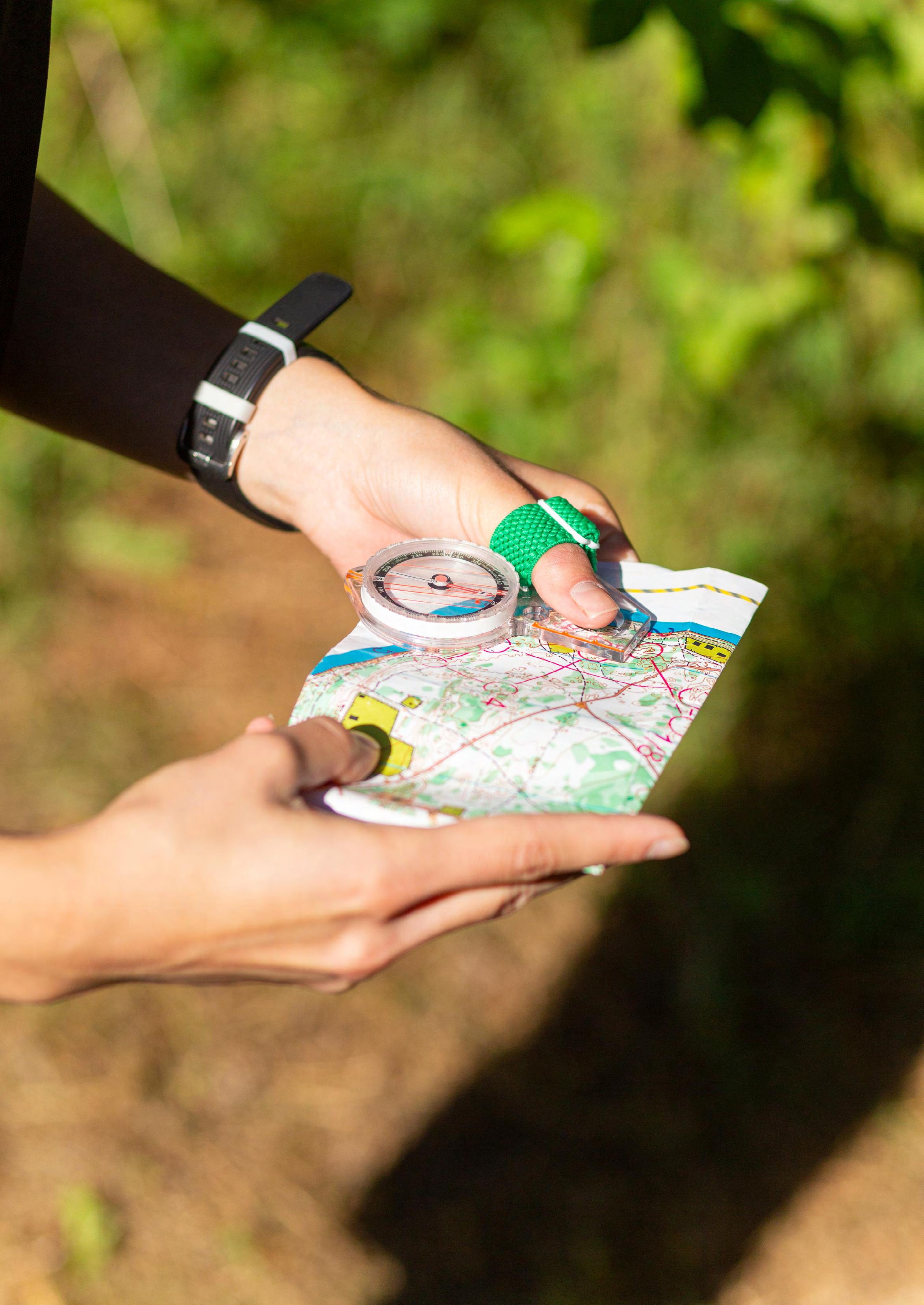
European Youth Orienteering Championships 2025 (EYOC2025) will take place inBrno, Czechia, 17 – 20 July 2025. https://eyoc2025.cz/ Programme:
17 July - arrival, model events
18 July - long, opening ceremony, friendship party
19 July - sprint
20 July - relay, closing ceremony, departure Competing classes:
MW16 – born in 2009 or later MW18 – born in 2007 or later Czech O-Tour, three great races, will be organised on 18-20 July for all spectators and parents.
An AUS Team for the trip to eyoc2025.cz
We are planning to assemble a team, coordinate flights, accomodation and transport in Czechia. Our aim is to have at least two relay teams at EYOC2025. If you would like to attend, please get in touch with Marina Iskhakova (team coach) and Fedor Iskhakov (team manager) marina.iskhakova@gmail.com

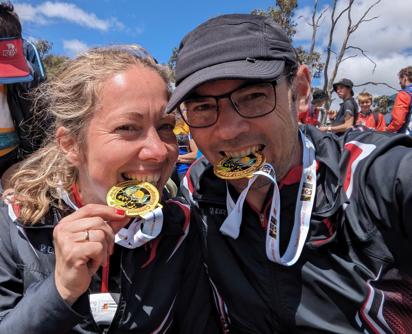
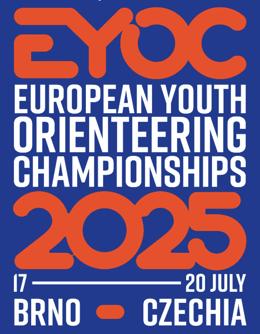

DAVID ROSEN (ASSISTANT REFEREE AT WOC 2024 AND THE CHAIR OF THE IOF RULES COMMISSION) COURTESY OF COMPASSSPORT 40TH WORLD ORIENTEERING CHAMPIONSHIPS SOUVENIR PROGRAMME
WOC 2013 FINLAND In the Sprint Qualification race, a runner jumped over an ‘uncrossable’ fence and then (realising his error) jumped back again. The organiser disqualified the runner. He subsequently complained and then protested on the grounds that he had not gained any advantage from his error and had done his best to reverse it. The jury agreed and upheld his protest so he was reinstated.
WOC 2014 ITALY There were six protests in the sprint qualification. They all related to what were claimed to be small defects in the map. Various teams felt they had caused their competitors to lose the vital seconds which meant they failed to qualify for the final. The jury carefully considered all the protests but in every case decided that any minor map defects should not have materially affected navigation, and rejected the protests. Most of us recognise that maps can never be 100% perfect. Unlike a stadium-based sport where conditions can be quite strictly controlled, orienteering can never be completely fair. But we are prepared to tolerate this in return for the joy of competing in the natural or urban environment. In the forest, the underfoot conditions can only be approximately indicated and the ground may ‘track up' during the race. In urban terrain, the public may be walking around and causing minor obstructions, and building work may appear overnight.
WOC 2014 ITALY In the Sprint Relay, the new SPORTident Air+ (touch-free) system was used successfully and just one protest was made in the case of a runner who failed to record a punch. The jury rejected the protest. There was no evidence of any equipment malfunction and it is the runner’s responsibility to check (by the flash of the Air+ SI card) that a punch has been recorded. Note that with SPORTident Air+ there is normally no record of the punch other than in the card as the communication is just one-way – from the control to the card.


WOC 2014 ITALY In the Long Distance final a runner thought they had punched correctly at the last control but there was no record in their (standard) SI card. There was video evidence that the runner had inserted the card in the control box, but the video did not show whether the box had beeped and flashed. The jury rejected the protest citing rule 20.5. A competitor with a control punch missing or unidentifiable shall not be placed unless it can be established with certainty that the punch missing or unidentifiable is not the competitor’s fault. In this exceptional circumstance, other evidence may be used to prove that the competitor visited the control, such as evidence from control officials or cameras or read-out from the control unit. In all other circumstances, such evidence is not acceptable and the competitor must be disqualified. In the case of SportIdent, this rule means that: If one unit is not working, or appears not to be working, a competitor must use the backup provided and will be disqualified if no punch is recorded.
WOC 2016 SWEDEN During WOC16 there was just one protest. This concerned an athlete who had been disqualified because she did not record a punch at one control in the Sprint Relay. The athlete’s emiTag worked correctly for all the other controls, and the other athletes all recorded a punch at that control. The athlete was the first to visit the control and the protest suggested that perhaps the control might have ‘been asleep’. For Emit Touch Free controls, the control is turned on by pressing a button, so had the control been asleep, it would also have been the same for the following athletes. Of course the simple reason for the missing punch is that the athlete failed to get her emiTag close enough and then failed to check for the flashing light on the emiTag. So the jury rejected the protest.

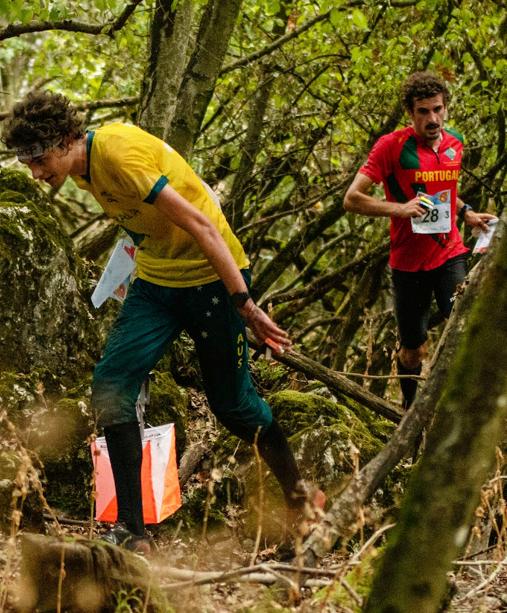

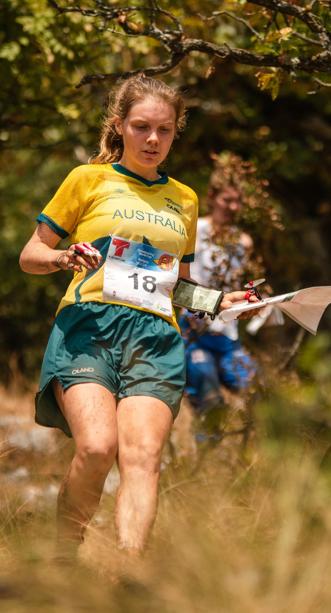

Eirik Langedal Breivik (Norway) and Simona Aebersold (Switzerland) won the European Orienteering Championships (EOC) Middle on very technical, Hungarian terrain that really challenged the runners.We saw big mistakes by many athletes, with Breivik and Aebersold managing to navigate well in the steep hills while keeping high speed.
In the men’s class Kasper Fosser (Norway) and Albin Ridefelt (Sweden) took silver and bronze, after both being ahead of Langedal Breivik a few controls before the finish. In the women’s class Natalia Gemperle (Switzerland) and Andrine Benjaminsen (Norway) took the other medals, with one of the biggest favourites, Tove Alexandersson (Sweden), finishing without a medal in fourth place after a big mistake early in the course. ‘Today it feels like I did all the types of mistakes one can make, Alexandersson said to Swedish media after the race’.
The big favourites Kasper Fosser (Norway) and Tove Alexandersson (Sweden) took clear victories in EOC Long distance, both with a margin of around 4 min to their closest competitors.
In the men’s class Daniel Hubmann (Switzerland) took an impressive silver medal – 18 years after he took his first EOC medal at the EOC Long distance in Estonia in 2006. Miika Kirmula (Finland) took the bronze medal after a strong last half of the course. In the women’s class the EOC Middle winner Simona Aebersold (Switzerland) took the silver medal ahead of the bronze medalist from the middle, Andrine Benjaminsen (Norway). Text courtesy of World of Orienteering, edited

Tove Alexandersson (Sweden) won both the long distance and the middle distance, and anchored Sweden to victory in the women’s relay in the World Cup final in Kuopio, Finland. In the men’s classMiika Kirmula (Finland) won the long distance, Eirik Langedal Breivik (Norway) the middle distance, and Sweden won the relay.
In the long distance race,Tove Alexandersson won the women’s event, finishing over 4 min ahead of Switzerland’s Simona Aebersold in second, with Sweden’s Hanna Lundberg taking third. Miika Kirmula won the men’s race for Finland, with Martin Regborn of Sweden in second and Finland’s Eetu Savolainen finishing third.
In the middle distance,Tove Alexandersson secured her 50th World Cup win, finishing ahead of Simona Aebersold in second, and Norway’s Marie Olaussen in third. Norway’s Eirik Langedal Breivik took the win in the men’s race, with Kasper Harlem Fosser of Norway in second, and Sweden’s Max Peter Bejmer in third. With these results, the overall World Cup went to Simona Aebersold and Kasper Fosser.
Sweden won both the men’s and women’s relays, securing the overall Team World Cup title. In the men’s relay, Gustav Bergman anchored Sweden to victory, while Norway finished second, and Finland third.The Swedish women’s team, led by Hanna Lundberg and Tove Alexandersson, dominated from the start, with Norway taking second, and Finland placing third.
Text courtesy of World of Orienteering, edited




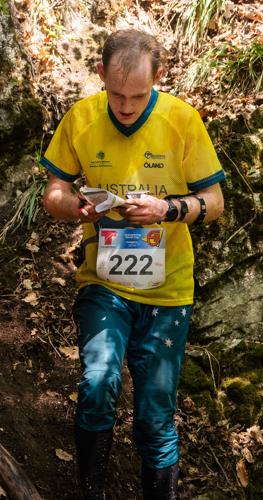






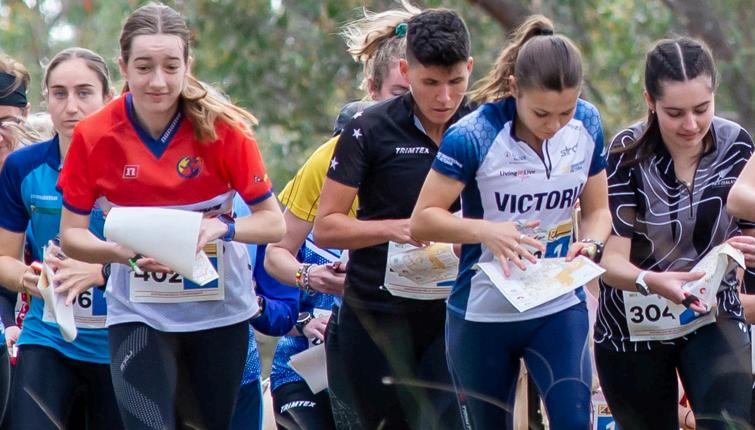
2024 was an excellent year for the NSW Stingers, taking three of a possible four team titles, as they did in 2023.They were especially dominant in both junior divisions, taking the maximum possible points from every round in both, and leaving the Canberra Cockatoos a distant second in both competitions.The senior men also opened up a big lead in the early rounds of the season, and although the Canberra Cockatoos and the Queensland Cyclones outperformed the Stingers over the Australian Championships week, the gap was too much for either to close.The Cockatoos were second and the Southern Arrows third.
The Canberra Cockatoos won their fourth successive senior women’s competition comfortably in the end, although both the Tassie Foresters and the Southern Arrows were competitive at various stages.The Foresters took maximum points from the opening weekend at home, while the Arrows led through much of the first half of the season but fell away once two of their key team members, Olivia Sprod and Emily Sorensen, went to Europe.The Foresters were second, and the Arrows third.
With the Australian Championships week counting for team results only, the individual titles were decided in May.The senior men’s competition was a head-to-head battle between Brodie Nankervis and Alastair George, who shared the first seven wins

Round 1 17-18 February HOBART, TAS 2 x sprint, middle
Round 2 29 March1 April EASTER THREE DAYS, SA sprint, middle, long & relay distance
Round 3 25-28 April BRISBANE, QLD 3x sprint (WRE, relay and knock-out)
Round 4 18-19 May ACT - NOL individual final middle distance & forest relay
Round 5 28 Sep6 October ARMIDALE, - NOL team-only final middle, relay, long distance & sprint
between them, but a second to George’s third in the final round was enough to secure what was (perhaps surprisingly) a first title for Nankervis. Grace Crane’s clean sweep of the four days at Easter gave her a commanding lead, and a final-round win at Wee Jasper removed any possible doubt, seeing her at the top for the third time in the last four years (and the fifth in total). It was a tight battle for second though, with Mikayla Cooper falling 15 s short of the second place she needed in the final round to overtake Caitlin Young for second overall.
The junior women’s competition was the closest of all, with Nea Shingler and Milla Key unable to be separated. Key got off to a flying start with wins in four of the first five rounds, but Shingler hauled the gap in with wins in the two individual sprint rounds in Queensland. A win for either in the last round would have been enough for the title outright but Shingler was second and Key fourth, with Natalie Miller taking the race. In the junior men’s it was a race between forest and sprint specialists. Sam Woolford’s dominance in the early forest races were enough to give him a score which could not be overtaken, but two wins in Queensland, including an outright win against the seniors in the knockout sprint, lifted Cooper Horley to second ahead of Callum White.

Orienteering coaches, team builders and squad managers are lucky to be able to share their love of the great outdoors, to encourage people to look beyond their devices, up and out at the world around them and to embrace the outdoors with a map. Whether teaching and leading, orchestrating training camps or driving change in our sport, theability to engage positively in winning hearts and minds through teaching orienteering can be so rewarding.
Clearly many orienteers enjoy this experience, as was evidenced recently when so many keen and competent parents and supporters came together at this year’s Independent Athletes Development (IAD) Camp to collaborate, inspire and water the seeds for a futureof engagement with orienteering.To all of the coaches and support people we thank you!
The IAD Camp, under various other titles, has had a presence on the annual orienteering calendar since 2016. Combined with an open-invitation-speakers program, this ‘academy’ of learning has served orienteering well in Australia. Many former development camp juniors have gone on not just to represent their state teams, but a handful have gone on to represent Australia!
This year was no different. Juniors from across the country and across the ditch came together for adventures, learning and loads of fun. Outside the pressure cooker of ASOC state team competition, juniors are able to learn, make friends and extend their technical skills, at a pace aligned to their individual needs. For some that might mean engaging only as day ‘campers’, for others perhaps a mid-week residential, and for many the full immersive nine days backed up with one-on-one training. Juniors are also able to witness possible pathways for themselves in our sport, as they compete alongside others striving for improved performance.All aspiring athletes and their families are encouraged to join the Independent Athletes Development Camp movement as part of the Australian Orienteering Championships in 2025 in Brisbane.

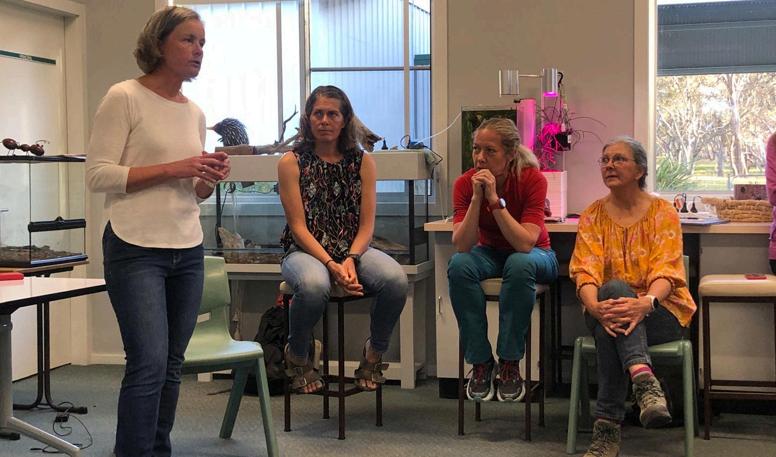
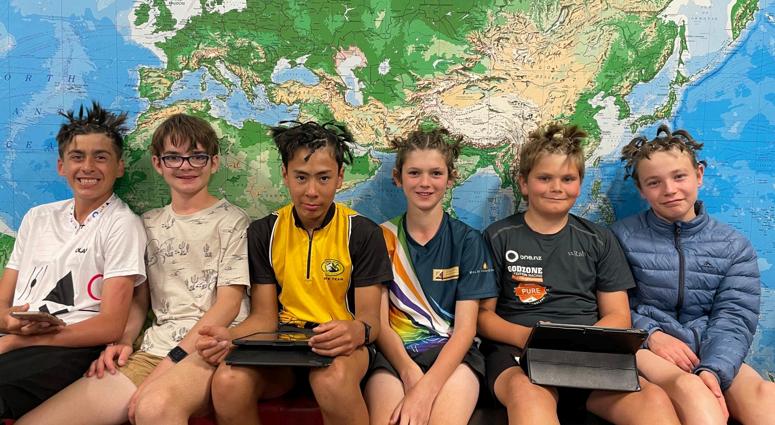

Tor: The best thing with camp was meeting new friends and playing games in the evening.
Sophie: The camp was really fun, and I loved meeting new people and making friends. The talks about navigating on granite rock were really helpful and I put to use the traffic light and boxing techniques.



Matilda (Queensland): I entered into the Independent Athletes Development team for the Australian Schools Orienteering Championships (ASOC). At first I didn't know what to expect or if the people would be nice. I only knew two people going to the camp, and came out the other end with heaps of new friends from all over Australia and New Zealand. The ASOC experience in general was amazing but it was a lot easy going and fun with the Independent Athletes Development team. At the camp we did multiple training exercises and listened to many other orienteers with lots of experience, like when we had a bonfire with a few elites and talked about how they become so good at orienteering and what countries they have orienteered in. Aside from that we had lots of fun doing activities like night orienteering and Kahoot. During our free time all of the campers came together and played fun games like hide and seek, and got to know each other. I would 100% recommend being a part of the Independent Athletes Development team. And the food was really good!

Nicole Cooper: It was with some anxiousness (and a little bit of jealousy)that I dropped my 14 year old daughter off, in a different state, for ten days of orienteering at the Australian Orienteering Championships and Australian Schools Orienteering Championships. I only knew two other girls going and none of the organisers, so was hoping that it was going to be a great experience for her. Well, I had absolutely nothing to worry about! I spoke to her only briefly each day, and it wasn't because there was no reception, it was because she was having so much fun! Toni and Helen were amazing, and I was kept updated with what everyone was getting up to. Matilda learnt and developed new skills, and her confidence has definitelygrown. She loved her time on the camp, and made so many new friends. She hasn't stopped talking about different things they got up to. Without doubt, a worthwhile experience for her.
Kate, mum of Clara: As a parent of a day camper I was so touched by the way my daughter was really included and supported and gently encouraged to belong. It was such a special experience to be a part of, and I am very grateful to the coaches.
Barbara: Thanks everyone for making the camp such a success.It was a pleasure to meet everyone, see new friendships grow, and see the growth in all our young athletes across the camp.
Malcolm: Just to add thanks from Tash and I for looking after and out for Andrew over the last ten days. He’s had a blast, would do it again ‘in a heartbeat’, made friends and learnt a lot. To the drivers, chefs, organisers extraordinaire and shoe finders - bravo! Thank you.
Jenni: Thanks very much everyone - Toni and Helen your organisation was amazing. I think the kids got a lot out of it! It also helped me as I thought I better follow my own advice, and I had some of my most mistake-free runs that I've ever had in Australia!
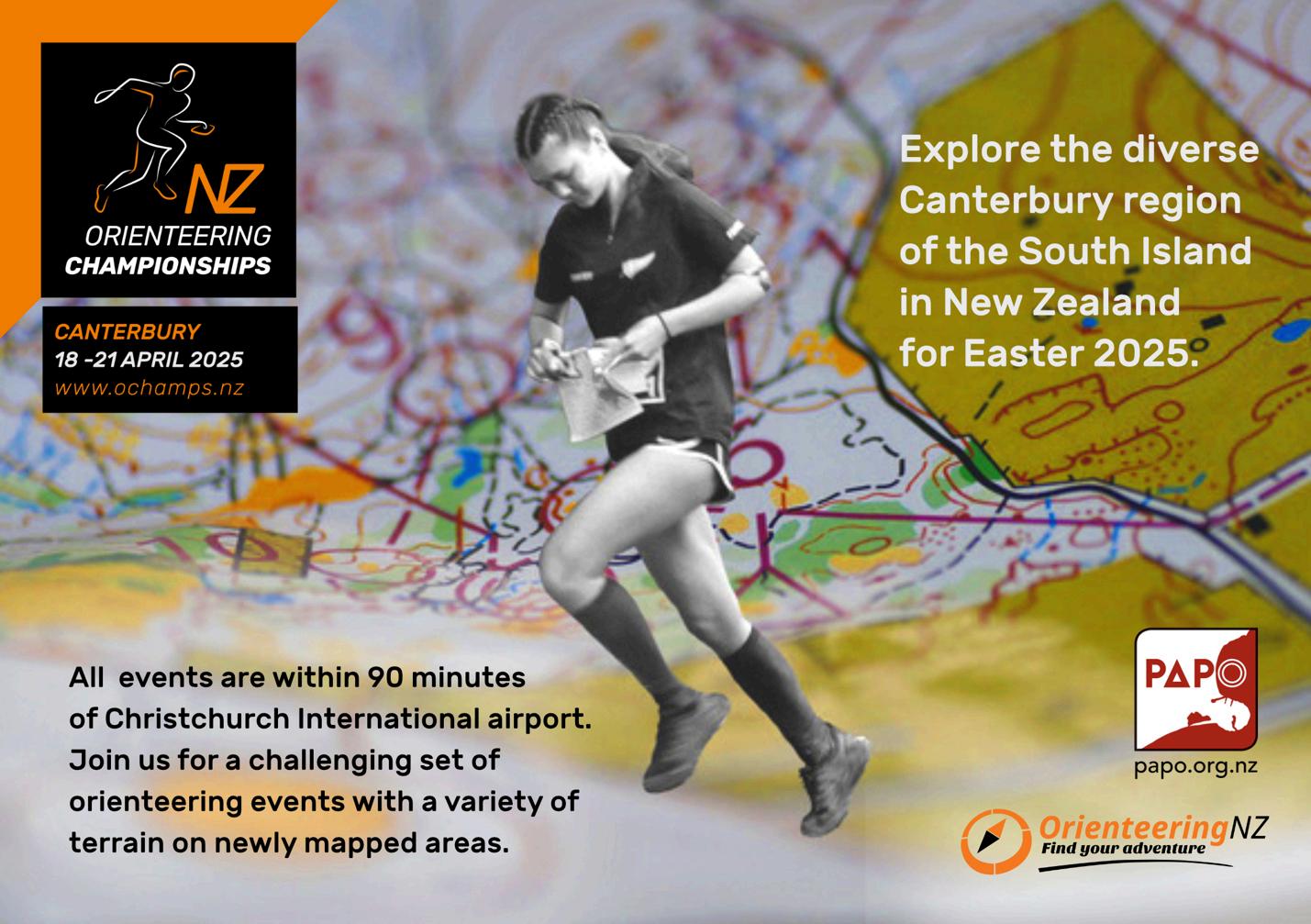

What are the five differences between the two maps?

1. On the MTBO map above what do purple short lines represent?
A. Obstacle.
B. Uncrossable barrier.
C. Drink station.
D. Information sign.
HANIA LADA
Draw on the map a control in the south west corner, and a control in the north west corner, then what you think is the best route choice between them if riding a bike on tracks only.

2. Where is the highest point on the map?
A. Hill in the east, close to powerlines.

B. The last contour in the south west corner.
C. Hill in the north near a short paved road joining two long paved roads.
The answers are on page 46.


https://forms.gle/M1VnkNSrDqnbPRqK8
Follow this link to post-print corrections, quiz and survey on one form. Check out what mistakes in the current edition have been discovered too late, feel free to attempt some or all quiz questions, and provide data by completing the survey.


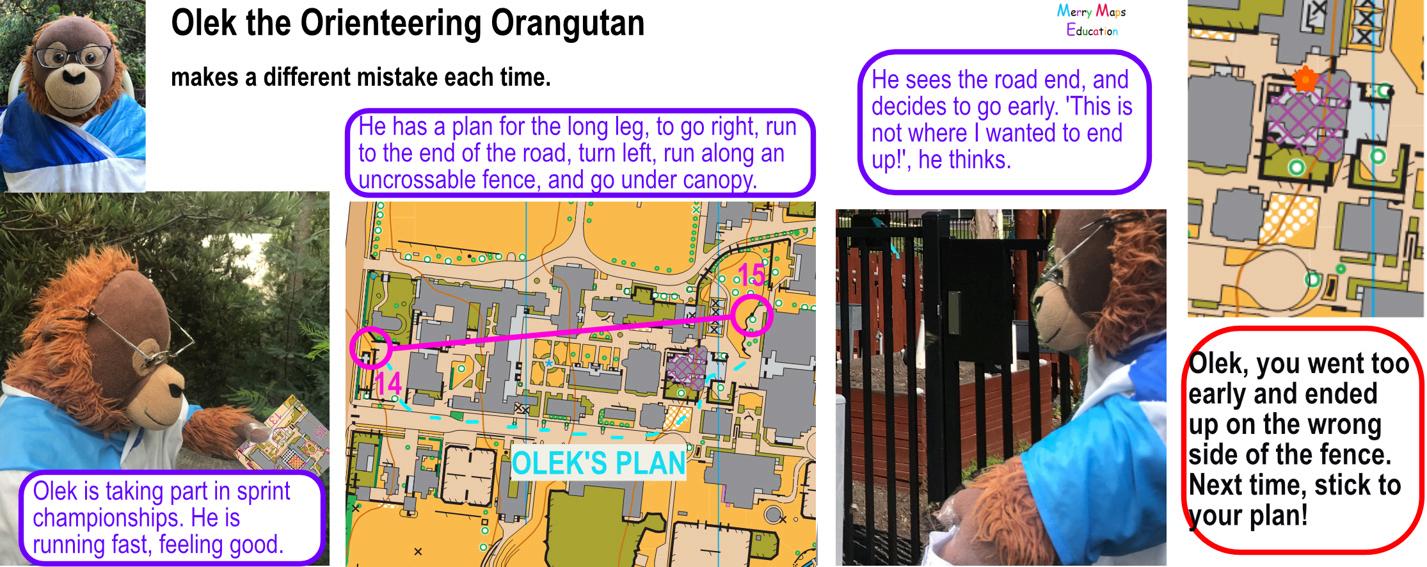

CLARE HAWTHORNE


Producedin February2020by KilianLilje

Question: What do Great Britain High Performance (GB HP) Squad members Ralph Street, Will Gardner, Peter Hodkinson, Peter Bray and Grace Molloy all have in common?
Answer: They were all Coaches in Residence in Australia!
In fact, a third of the current GB HP squad has taken part in the Coach in Residence (CIR) program.While we can’t take all the credit (or any of their medals), we’d like to think that our unique program helped them to grow and develop as orienteers, catapulting them to bigger (but definitely not better) things.
The CIR program is now in its tenth year, with more than 30 coaches from over a dozen different countries taking part so far. It provides a unique opportunity for young orienteers from all over the world to gain coaching experience and expand their technical skills in areas such as mapping, course planning and event organisation. Coaches can also compete against Australia’s top orienteers in a huge variety of terrain, make new friends, improve their language skills and even run alongside kangaroos - a highlight for many former coaches!
Victoria and New South Wales were active in the program [Victoria intends to restart it], and recently Tasmania, South Australia and the ACT have regularly engaged coaches from October through to April. Despite the restrictions imposed by their hot summers, Queensland, Northern Territory and Western Australia are also open to coaches looking to travel to Australia in the autumn/winter season. WA recently hosted Czech pair Jiri Vales and Veronika Kubinova after their summer coaching stint in Tasmania, while Queensland has secured significant funding for its program and is actively seeking a coach for the 2025 winter season. It's not a requirement for coaches to be elite level competitors themselves, however many have been top athletes in their home countries and almost all coaches have competed very successfully for their adopted states in the National Orienteering League. Continuing the tradition, the most recent addition to the Coach in

Residence family, Hanne Hilo of Finland, placed first in W21E in both the 2024 Australian long distance and sprint distance championships – a great personal achievement for Hanne, and a huge bonus for South Australia where Hanne will be based. Unfortunately, the competitive success of orienteers taking part in the program has sometimes led to the misconception that the CIR program only benefits elite orienteers. While coaches can certainly lift the level of the local competition and serve as great role models and mentors for our top juniors and young elites, this is simply a side benefit.The main purpose of the program is to boost participation by helping to create a supportive coaching environment for orienteers of all ages and abilities.This not only assists newcomers to develop their orienteering skills, but aids retention by reinforcing the social side of orienteering through regular training and fun, low-key competitions. Coaches often introduce new formats and training methods, such as Christophe Prunsche’s highly entertaining ‘Do as many courses as you can in one hour’ relay at Pittwater in Tasmania, which can provide a much-needed injection of variety into local training sessions. Less popular or uncommon types of orienteering in Australia, such as relays, MTBO and night orienteering, have all benefited from the expertise and enthusiasm of overseas coaches.
CIRs are also a great resource for programs such as Sporting Schools, where they can earn extra income while greatly assisting program coordinators. Many coaches have taken on team leader roles for state/territory schools’ teams and helped to organise national junior training camps.They have also produced a number of excellent maps, including high quality sprint and mountain bike maps that would otherwise not be available to local clubs.


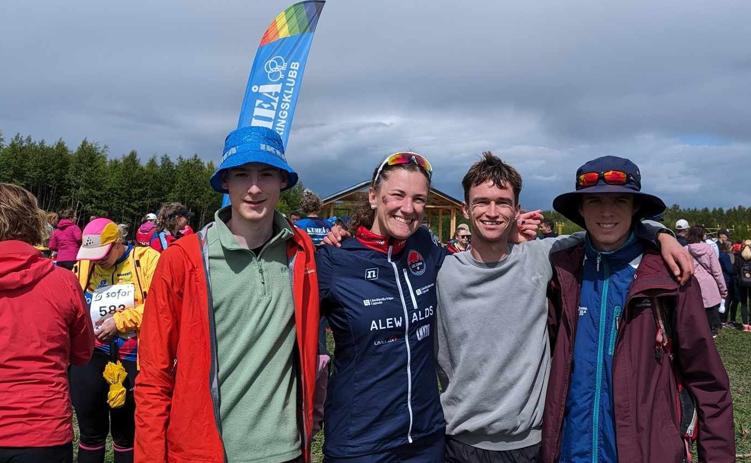
Francesca Taufer, an Italian coach based in Tasmania in 2022/23, had this to say about her experience:
My time in Tasmania was probably one of the best experiences in my life, and there are no words to say how thankful I am for my time there. I was supposed to stayfor five months but I enjoyed the experience so much that in the end I stayed for 11 months. Orienteering Tasmania is an amazing community, and I felt welcomed and at home from the first day. And the island is full of stunning landscapes!
My daily tasks were different and included setting training sessions for the clubs, teaching orienteering at schools or helping organise events. I also had the chance to travel and compete with the Forester team to the national competition and see different parts of Australia like Sydney, Melbourne and Perth (and also New Zealand!). I had the opportunity to see how friendly and nice orienteering in Australia is, where it is not all about competition but is also about making friends and having a good time.
I lived with different families both in Hobart and Launceston, and everyone took care of me by showing me the beautiful corners of Tasmania and making sure I fulfilled my Australian experience by teaching me cricket rules or how to do a Tim Tam slam.
I had the chance to run in completely different terrains and on cool maps, enjoying running together with wallabies and wombats (and only nine snakes…)
I'm already looking forward to my next visit!
I would definitely recommend this experience to everyone who loves and is addicted to orienteering.
More information about the Coach in Residence program, including how to apply, can be found here: https://scholar. orienteering.asn.au/
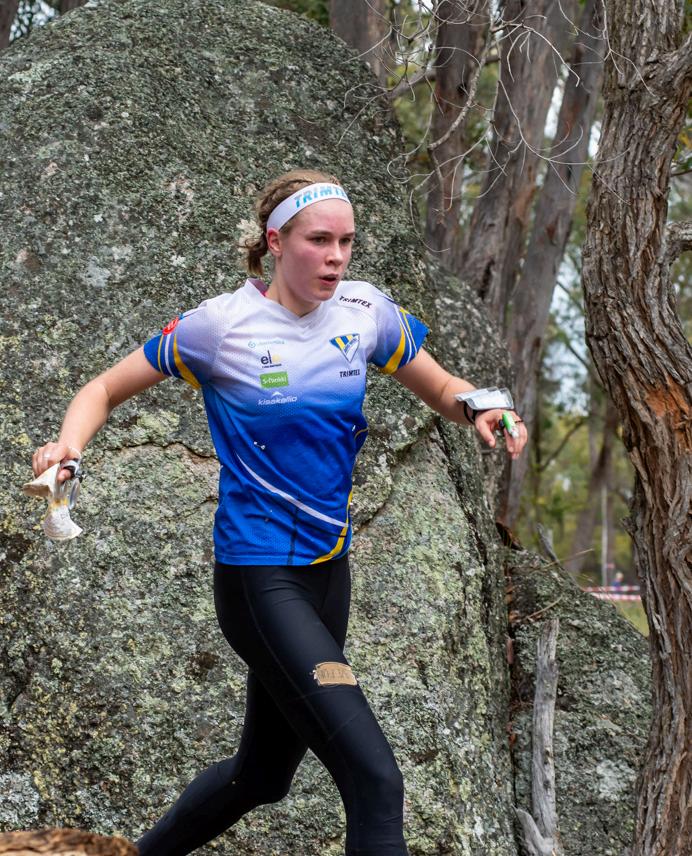

COURTESY OF SA ORIENTEER ISSUE 4/2024


Arriving on Thursday morning I was taken straight from the Armidale airport to the competition to watch the others compete, and I got handed the previous day’s map so I went for a map walk. It was an interesting experience, my first time in Australian bush and very different terrain and mapping style compared to Finnish and European ones. But nonetheless a very insightful experience, just walking and slowly running a 2 km loop (after 30 h of travel), looking at how the features are mapped, what to trust and where to run. The terrain wasn't obviously the same as at the long distance, but I had watched the maps from the middle and relay from the same terrain and a bit of the broadcast, just to know what I should expect, because I had no clue to what kind of terrains I would arrive to.
So, at the start of the long I was just smiling to myself, feeling confident that this will be a good race in the sense that I'm in okay shape (not the best since I’d had three weeks off-season not training much and doing loads of other stuff before leaving Finland), and I really want to excel on this course. So, my attitude was on point and I was ready to have fun. I started out quite hard just hitting those short legs, getting a good confidence in the terrain and my orienteering and almost catching Kaia with 2 min before the long leg. But instead of rushing in the direction she went I took some time to plan properly the long route, according to my game plan, which was to play it safe if in doubt since I hadn’t mastered this terrain yet.
During the long leg I started feeling fatigue, just 20 min into the race. Clearly the jet lag, lack of sleep and irregular eating had hit me, in combination with the heat and a too-speedy start. I told myself that the fight starts already now, that I have 70 min left and it will be longer and more painful if I don't start focusing extra due to being tired. So more map contact, be extra sure when you leave a secure object, etc.
At control 7, I saw Kaia coming behind me for a drink and took some time to consider control 8, which looked very tricky. Going straight or right looked the fastest but I decided to stick to my game plan, play it safe and take the left route. It was about 1 min or so slower, however it was risk free. I ended up losing 1 min to Grace Crane on that leg, whereas it looks like others ran past the control going straight. So afterwards I can tell that I made the right decision, running according to my plan and not paying attention to others even if it's a long distance, and you benefit from running with others.
Fast forward, I keep doing the work, one control at a time, just full focus on what I'm doing. At control 12 the camera man starts to run behind me and I've decided that I need to drink two cups of water since I've only gotten one on the other, because I wasn't expecting self service and I haven't followed my hydration plan (I did also take two gels during race). I struggle with the canister, but even if the camera is there in my face I don't let it bother me or the fact that I see already control 13 across the field and I know exactly where to run. I get back into the race and don't panic, remind myself to read the map even more to get back into the flow after the disturbance. From there I take the controls one at a time, slowing down my pace a bit since I know I've had a good race and I don't want to kill my legs for the next day’s sprint. I'm coming close to the end, and the bush changes a bit making it runnable with easier navigation, but I keep my mind even more focused because here it's even easier to make mistakes, you hear the arena, you know you have done well, there is a TV camera following you.

Hanne’s GPS track can be found here: https://www.tulospalvelu.fi/gps/20241005auslongw21/ P.S. Hanne also won the AOC Sprint in the W21E class.
I get back into my bubble, be extra sharp on these last controls to finish off all the work I've done. I come to the last control, I'm so happy, no mistakes on controls, good choices. Afterwards when analysing the performance you always find places where you could have done better; in this race I had a few poor executions adding up to2.5 min and that one route choice that was 1 min slower. However, running down the run-in seeing the South Australian kids cheering me on, I just celebrate, letting all the emotions loose that I kept in check for the last 90 min. No matter the result I already know I'm a winner and I let it show. And of course it's a cherry on top of the race to get the gold, but it's for OSA and a pretty epic souvenir to take home.
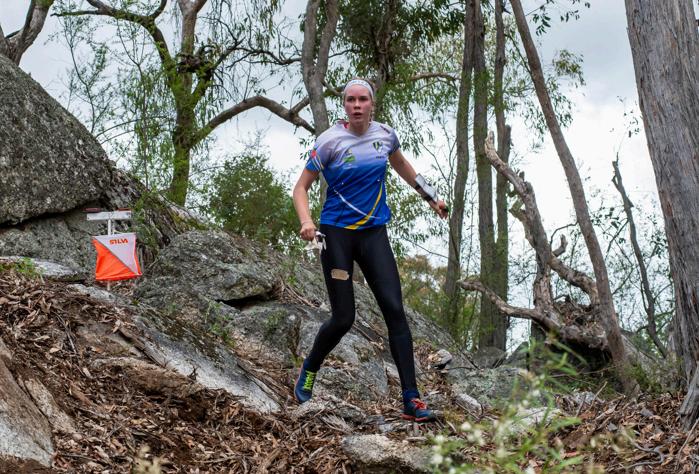


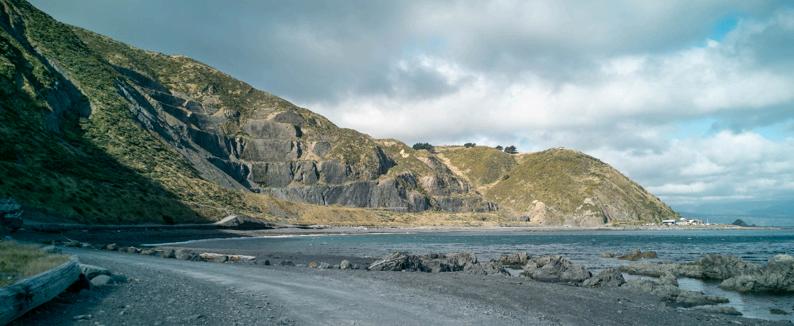



Aotearoa New Zealand is a great place to visit, and the Manawatū and Taranaki regions offer some spectacular scenery and opportunities to extend your orienteering trip into a memorable holiday.
The warm-up events in New Plymouth are a great chance to immerse yourself in the beauty of the TSB Festival of Lights at Pukekura Park. Enjoy the long summer nights and relax with free live music every night.
The Oceania 2025 events are all within an hour’s drive of Palmerston North, making it a good base. The city’s flat terrain is perfect for training and recovery runs alongside the Manawatū River, and our local MTB fans recommend the Arapuke Forest Mountain Bike Park.
Nearer the events, the windmill in Foxton sells Dutch goodies, and Cafe de Molen is right next door – you can combine this with a visit to Te Awahou Nieuwe Stroom to learn about Māori and Dutch history in the Horowhenua.
You’re likely to travel via Wellington airport, so it’s worth taking a couple of extra days to experience New Zealand’s ‘coolest little capital’. The city has a huge variety of craft beer bars, a fun local music scene, jazzy cocktails, fantastic restaurants, and consistently amazing coffee, plus the national museum Te Papa on the waterfront.
A run round the bays is a fun way to see the city from sea level, but there’s adventure to be found too. The Skyline Track, Catchpool Valley and Pariwhero (Red Rocks) are all beautiful areas offering anything from easy beach walks to steep technical bush trails. Definitely something for everyone.
We can’t wait to see you here in January!



‘The best event I've ever done!’
‘I’m so glad I flew 24 hours from Northern Ireland for this!’ 'Best control ever!’
'The most fun I've had orienteering!’
‘This was just the best race, definitely coming back from NZ to do it again!’
That’s just a tiny fraction of the comments received after staging the inaugural Sydney City Race on Sunday October 13. Not an ordinary orienteering event, the race was intended to be a combination of fun run and urban orienteering race, while showcasing the iconic sights of Sydney.
There were five courses, 15 km, 10 km, 6 km, 3 km and 60 min score. Each was a mix of intricate orienteering, route choice and pure running legs. We wanted to blow competitors minds visually, then blow them again conceptually when tired from running hard or distracted by the sights.
We created a wow factor that few urban orienteering events anywhere in the world could possibly hope to match. A control on top of a Sydney Harbour Bridge pylon with 360-degree views. A control in front of the Sydney Opera House, with resident seal Benny on the steps nearby. Controls beneath the Sydney Harbour Bridge, and in Barangaroo,The Rocks, and Hyde Park. $1000 prizemoney for the men’s and women’s 15-km winners. A dedicated website targeted at attracting runners, ultra runners and adventure racers (www.sydneycityrace.com.au).
We achieved our aim of attracting newcomers, there were 120 beginners among the 332 starters. Entrants came from all over Australia, New Zealand, Germany, UK, Brazil, Northern Ireland,
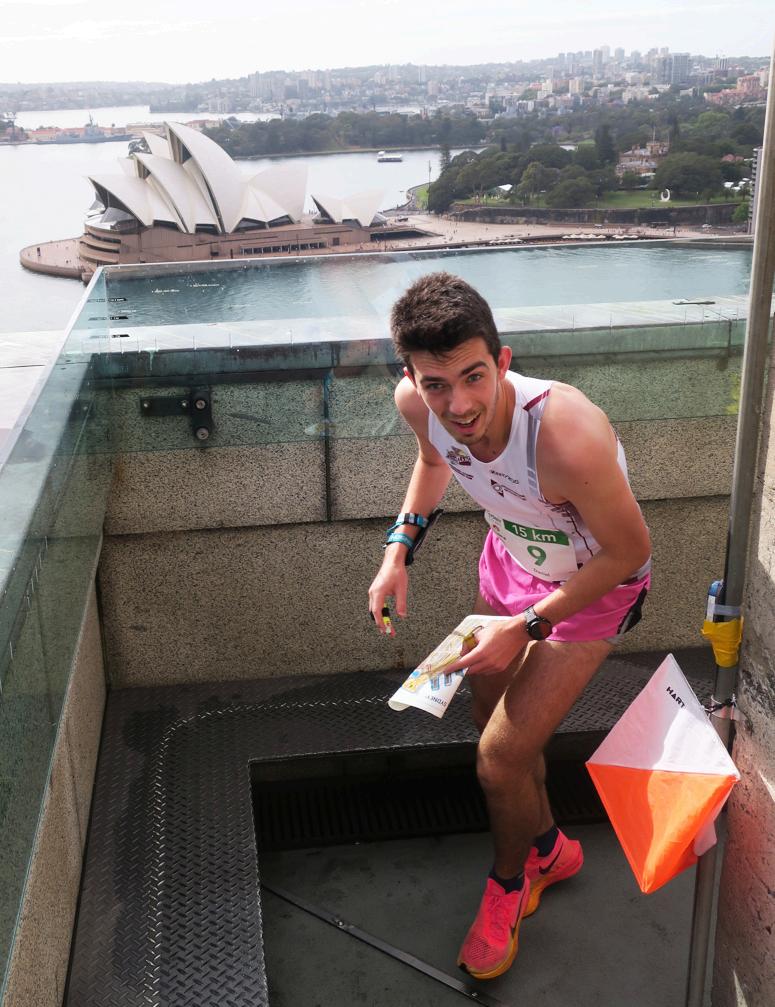
The orienteering event that put Sydney on the map!


and New Caledonia. A group of Brazilian first-timers spent nearly 15 min atop the pylon Instagramming! This was not just an event for them, it was an experience, an adventure, a thrill!
One of the nicest stories (and there were loads of them) from the event occurred while race organiser Sheralee Bailey was setting up the pylon control late Saturday afternoon. A tourist from Germany was still at the top of the pylon admiring the views. When he saw the control, he said: ‘Is there orienteering here?’Within minutes contact details had been exchanged and the next morning he ran the 15 km race (visiting the pylon twice in as many days), then left for home on a 7 pm flight that evening!
When Sheralee first raised the idea of a Sydney City Race last year, Ian Jessup immediately said he was in, and he had the one thing that would decide if the race was possible, contacts for key landowners. Having run in plenty of overseas City Races, Sheralee had lots of ideas to make the Sydney City Race unlike any otheralthough Ian objected to some of the ideas, ‘No, we can’t have a control on a ferry/in an elevator/on the casino roulette wheel!' For the rest though, we were going to need some special permissions! After much to-and-fro in the negotiation process we had permission from Bridgeclimb Sydney (pylon control), the Sydney Opera House Trust, Property NSW (The Rocks and Barangaroo precincts), City of Sydney Council, and Fort Street Public School for the use of the grounds for the assembly and for opening the canteen on race day.
Looking at the racing, competitors started at 30-s intervals, in race bib reverse number order, with the top seeded runners starting last. This meant competitors knew if they’d caught someone, or been caught! It also meant that earlier competitors could experience the elites running past them along their course.There aren’t many other
sports that give competitors the chance to get overtaken by an elite competitor running at 3.5 min/km – such a thrill!
The 15-km race started with a short run to the top of the harbour bridge stairs where a marshal directed runners to the pylon, where even more marshals directed them all the way to the top. How many times have you seen someone grinning from ear to ear after climbing 300 steps to a control? You have now!
The men’s 15-km winner was one of Australia’s perennial No.1ranked orienteers Julian Dent, in 60:55, winning by 2:04.The women’s 15-km winner was Tasmanian rising star Mikayla Cooper in 78:55, finishing 2:41 in front. Coincidentally, both were the fastest Aussie elites in the Australian Middle Distance Championships two weeks earlier. How was that for predictive results!
After the race, Julian described it as, ‘A world class sprint area, worthy of a Sprint Orienteering World Championships! The map was very detailed with areas of complex buildings, tunnels and multiplelevels which provided some very tricky and difficult route choices. A real orienteering challenge which was intense throughout the 60 minutes. A fantastic race concept to bring to
MEN – 15 km
1 Julian Dent NSW 60:55
2 Ewan Shingler NSW 62:59
3 Alastair George NSW 63:19 WOMEN – 15 km
MEN – 10 km
1 Curtis Pepper NSW 46:42
2 Ewan Barnett NSW 48:03
3 Richard Mountstephens NSW 48:03
MEN – 6 km
1 Malcolm Roberts NSW 41:34
2 Ian Dodd VIC 41:38
3 Steve Pyatt NZ 43:21
MEN – 3 km
1 Eino Lehtonen NSW 21:22
2 Andrew Lumsden NSW 22:05
1 Mikayla Cooper TAS 78:55 2 Nea Shingler NSW 81:36 3 Briohny Seaman NSW 83:36
WOMEN – 10 km
1 Paula Shingler NSW 55:38
2 Savanna Sweeney NSW 57:21
3 Lilja Lehtonen NSW 57:31
WOMEN – 6 km
1 Mikayla Enderby NSW 35:55 2 Karla Burnett NSW 39:08
3 Marquita Gelderman NZ 40:00
3 Bill Vandendool VIC 24:21 WOMEN – 3 km
1 Airdrie Long NSW 21:05 2 Tania Kennedy NSW 24:16
3 Carolyn Jackson VIC 24:33
Australia and a great new addition to the Australian orienteering calendar! A race all Australian orienteers should compete in!’
Mikayla was a late entry but it more than paid off in many ways, ‘When we popped out at Barangaroo looking up at the Harbour Bridge it was guaranteed to be a good day.The course took us to some pretty iconic places, which was super cool as a non-Sydney dweller. It was such a fun experience! Being able to see so many others out on course was super cool, being around so many people, with the boys catching up and overtaking me just when I needed a boost of energy helped me out there. It also felt great not being the only weird one running the streets with a map.Thank you so much to the organisers of SCR for putting together such an iconic and cool event - I’ll definitely be back!'
To truly capture the essence of the race, photos are available on the website here: https://www.sydneycityrace.com.au/photos
We already have a Melbourne City Race. Now we have a Sydney City Race. Who else wants to join in? Sheralee and Ian are more than happy to help clubs get their City Races happening, including in regional cities. We’re already planning the next Sydney City Race for early 2026 – what will the special control be this time?!

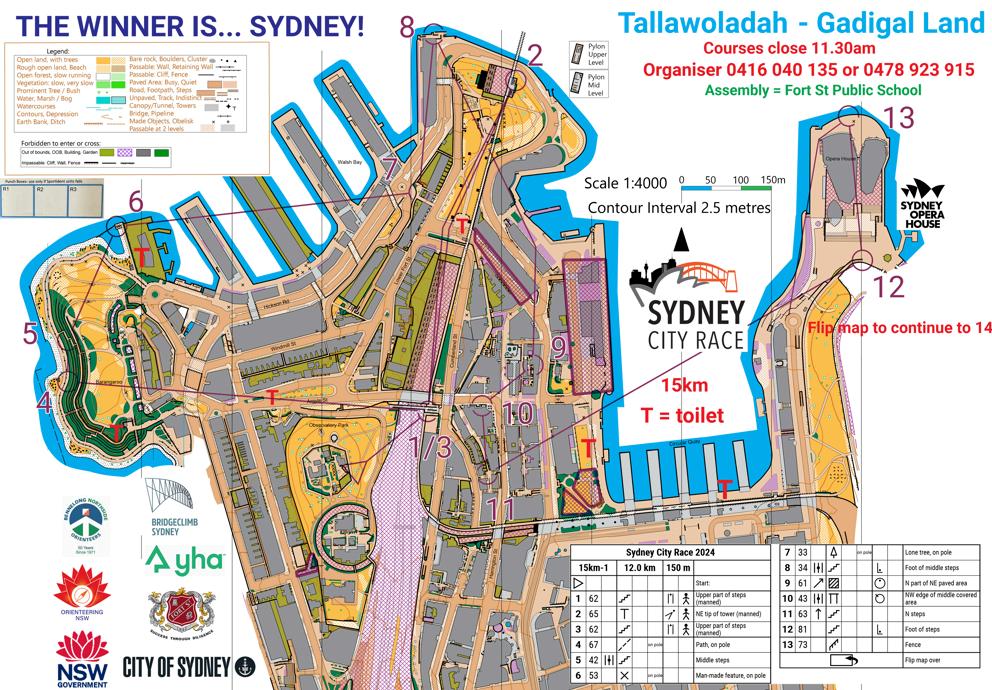
How would you go from control 11 to 12, and from 19 to 20?


DARRYL ERBACHER - OA STATISTICIAN
The Silva Medal winner is the Australian orienteer with the maximum number of points accumulated from their best six designated events. In the event of a tie, the Silva Medal is determined by count back using the average of the six best winning margins.
The 2024 Silva Medal has been won by Alex Tarr (M80, YV V) for the fifth time over a period of many years (1976 inaugural year, 1977, 1987, 2008 and 2024) on a count-back, having been one of a number of orienteers who attained maximum points (24). Congratulations Alex.
However, Alex didn't have it all his own way as Matthew Crane (M40 AO A) also performed magnificently, trailing Alex by just 0.82% points. Well done Matthew.
Completing the trifecta of orienteers who won all six events and gained maximum 24 points is Ted van Geldermalsen (M70 YV V). Well done Ted.



DARRYL ERBACHER – OA STATISTICIAN. PHOTOS BY TERRY COOKE.
Rankings in non-elite classes have been determined based on results in the Australian 3-Days (31, 32, 33) and the Australian Championships (AS, AM, AL). Points are awarded for each event (at least four starters) completed, on the basis of 100 points for first place, and lesser points for other competitors [in relation to the winning time for the given class]. When more than one orienteer in a class has 100 points, the first-ranked orienteer is determined by the average of their three best winning margins.
The first ten orienteers ranked in each class with rankings above 50 points are published in The Australian Orienteer
Some points of interest in the 2024 rankings:
Winner by the largest margin was Alex Tarr, M80, YV Y, 16.14%. There were two classes where two orienteers scored 100 points: W18 – Sienna White (LI S), Rebecca Craig (NC N); M65 - Eoin Rothery (RR A), Geoff Lawford (AO A).
There were 32 clubs that had members ranked in the first three places: RR A (14); AL T (13); AO A (7); PO A (5); BK V, MF V, NC N, SH N, YV V (4); WR N, CC N, UG Q, GO N (3); WH N, SO Q, LI S, TJ S, BF N, BN N, BO W (2); EV T, ST N, RR Q, WA S, GS N, BG V, YA S, DR V, BB N, EN Q, KO W, CH V (1).
The classes with most ranked runners were, for the women, W16, (17), and for the men M75, (20).
The most successful states for first places were: ACT (12), NSW (10) and Victoria (5).
In 2024 points were awarded for Day 1 (30 March, Pymton), Day 2 (31 March, Ngarlta) and Day 3 (1 April, Narrinyeri Hills) of the Australian 3-Days, the Australian Long Distance Orienteering Championships (5 October, Rola Birkungirra), theAustralian Middle Distance Orienteering Championships (28 September, Rola Latherana) and the Australian SprintOrienteering Championships (6 October, UNE Armidale) as follows: first – 4 points, second – 3 points, third – 2 points, for otherwise finishing – 1 point.
Those orienteers who obtained 20 or more points are listed below.


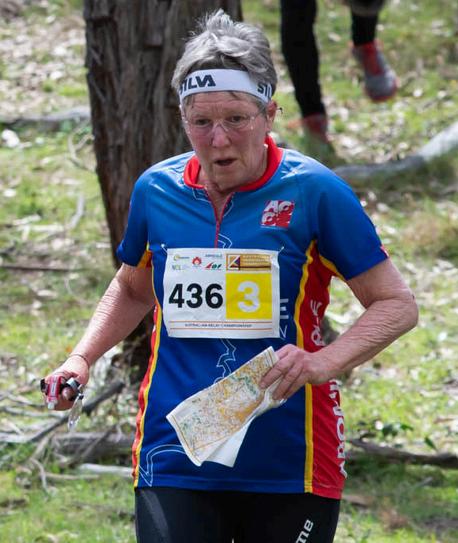









W35 club points events
1 Taria Smyth SO Q 100.00 ALAMAS

3 David Hogg PO A 78.02 AS3233
4 Trevor Sauer SO Q 64.56 3332AM
M75 club points events
1 Paul Hoopmann TJ S 100.00 AM32AL
2 Tony Radford BG V 98.32 323133
3 Ross Barr GO N 95.19 3133AS
4 Steve Flick BN N 94.17 31AS32

W18 club points events
1 Sienna White LI S 100.00 313233
1 Rebecca Craig NC N 100.00 AMASAL
3 Stephanie Dun ST N 59.48 ALAMAS
W16 club points events
1 Ariadna Iskhakova RR A 100.00 AM32AS
2 Alexandra Edwards RR Q 96.02 ASAL31
3 Katie Clauson AL T 95.55 3133AS
4 Mira Walter RR A 94.46 AL3332
5 Amy Dufty BO W 89.05 ALAS33
6 Sophie Hartmann AL T 87.05 3133AS
7 Keely Williams BG V 87.02 ASAL32
8 Xanthe Schubert RR Q 85.11 AS33AL
9 Katy Hogg PO A 84.43 ALASAM
10 EllaMaja Lang YV V 83.37 ALAS33
W14A club points events
1 Veronika Iskhakova RR A 94.80 333132
2 Ella Clauson AL T 94.20 AMALAS
3 Angelina Kozma BK V 85.08 313332
4 Alma Walter RR A 84.20 32AL31
5 Neve Lommers LO W 70.94 AS32AL
W12A club points events
1 Tessa Radajewski PO A 98.60 ASAM33
2 Beatrix Louis AL T 97.27 3331AM
3 Layla Dent RR A 93.12 ALAMAS
4 Lucinda Barnes RR Q 90.74 313332
5 Isobel Newton NC N 85.95 ALAMAS
6 Scarlett Ashforth WA S 83.27 323133
7 Ruth Toomey AD W 81.67 AMALAS
8 Banjo Bluett-Jones AO A 78.56 3133AM
9 Alexandra Slater GS N 70.43 ALAMAS
10 Eleanor Hobbs WA W 60.01 ASALAM
W10A club points events
1 Rui Bluett-Jones AO A 100.00 3132AS
2 Kira Farquharson WA S 84.02 333231
3 Freja Dent CC N 83.84 AMALAS
4 Chloe Marcant AL T 83.19 ASAMAL
5 Lucy Jenkins NC N 82.47 AMAS32
6 Florence Crane AO A 79.62 ALAMAS
7 Hayley Jenkins NC N 70.15 ASAL33
8 Abigail Hewitt AL T 64.62 ASAL33
9 Eleanor Hallett TE S 63.01 323331
5 Jim Lee NC N 88.55 AS33AL
6 John Oliver WR N 82.47 313332
7 Ian Fletcher LO W 80.14 31ASAM
8 Greg Hawthorne AL T 78.67 3233AL
9 Robert Lewin NC N 77.46 313233
10 Ken Brownlie WO W 75.67 32AS31






1
3 Simon Louis AL T 69.34 AS33AL
4 Lachlan Hallett TE S 69.01 333231
5 Justin Stafford NC N 65.37 33AMAS
6 James McQuillan WH N 62.11 ASAMAL
7 Richard Ward AL T 56.59 ASAMAL
8 Samuel Wilson RR A 54.22 ASAL31
Orienteering August 31 - September 1 2024 in Australia. Total participation at least 1349.


NORTHERN TERRITORY Lee Point Night (27) QUEENSLAND
OY Priest Gully (90)
Big Foot Sprints race 1 and 2 (216)
2024 Sydney MapRun #6 (19)
2024 Metro League #5 (170) NOY 8 (65)
Goldseekers Bush #7 (45)
Waggaroos Local Event (10) Kendall Orienteering (40)
MapRun Parks, Gold Coast (22)
MapRun Parks 2024, Teralba Park (19)
SOUTH AUSTRALIA
Mt Crawford Forest (83)
Southern Yorke Peninsula L2O (?)
TASMANIA
Junior Training Camp, day 2 and day 3 (42)
VICTORIA
Bendigo Bush Wildflower Drive (74)
Vic MTBO Sprint Champs (52)
Vic MTBO LongChamps (57)
Mornington Peninsula Sunday MapRun (6)
MFR training (25)
WESTERN AUSTRALIA
Bush 11 Frazzle (68)
Exploring the intriguing technology behind orienteering so you can use it too!
Some people collect stamps, teaspoons or tea towels, others collect clothes, shoes or ties… but I collect maps! I enjoy flicking through my display folders filled with the maps I have orienteered on. Every map is like a photo album, I picture the scenery from different parts of the course. Sometimes it is like a movie as I visualise what it was like running through that section of the map. If I go far enough back, I will find my route drawn on the map. It was a wonderful exercise tracing where I went with a ballpoint pen…and sometimes very humbling!
I encourage those developing their orienteering skills to draw their route on the map. It is also a very valuable skill for everyone to do (and fun). At least go over your route mentally because so much learning can happen through the visualising review.
‘But Livelox does it for me!’Yes, I agree, it is awesome. When that little red swirling arrow button in the Eventor calendar is clicked you are transported through that red whirlwind back into the map! Uploading your GPS track to the Livelox program helps you see yourself as a little colourful dot moving around the map: using those handy attack points, running straight to that vague control… or making that 180-degree error!
Maybe hand-drawing your own route is more beneficial, but a GPS record of your course offers a ‘true’ record of where you went. And comparing people's routes is fascinating and insightful.
Livelox (short for Live Location) is becoming Australia's orienteering reflection tool. So, let's look at how to use it so you can improve your orienteering skills too.
Anyone can access Livelox. Just click the little red swirling arrow next to the results button on the Eventor calendar. You can select any course and see the routes of those who have uploaded their GPS tracking. Even if you don’t upload your route, it’s fascinating to see which route your competitors took.
Uploading

First you need to track your orienteering course with a GPS watch or a phone app.Then sign up to a Livelox account and follow the ‘Upload route’ button. Clear instructions are on the Livelox website for a range of programs like Strava, and devices like Garmin. You can even set your account to synchronise with Livelox so your route will automatically appear after finishing.
Comparing

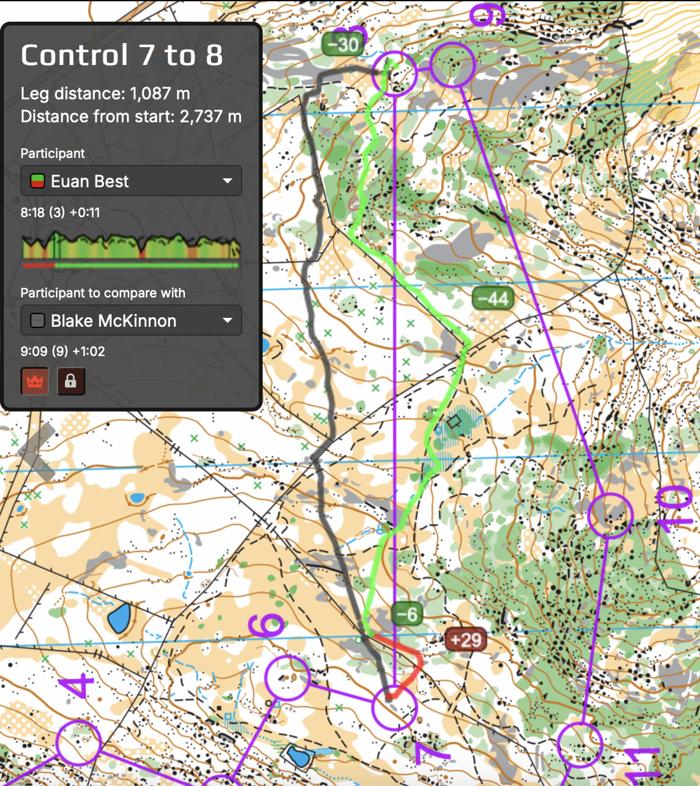

The fun continues when you purchase a Livelox subscription to access extra features (thanks Orienteering Western Australia for giving free access to all your members). Multiple participants: more than one participant’s route can be shown at the same time. Mass start: start every participant's route at the same time to show comparative achievement. Duel: compare and analyse the relative positions of two participants as they split for different route choices. You can sample the full features of Livelox by exploring the 2024 Aus MTBO Champs.
I think Livelox is a wonderful combination of orienteering and society’s technology. It’s sitting there ready for you to use it too, and I hope it improves your route choices!


BLAIR TREWIN, COURSE SETTER
The 2024 Victorian Long Orienteering Championships was held on the Nuggety Range map, used for the 2022 Australian Long Orienteering Championships.This is a hilly map, and also has numerous areas of private land scattered through it, a combination which makes for lots of potential for long-route-choice legs. The longest leg on the course was common to the five longest courses, and the route-choice options spanned the full width of the map.There were five broad route-choice options. A fairly straight option using the tracks along the main ridge was quite popular. Other options included a far left version using the road on the western boundary of the map; versions towards the left and above the upper edge of the private land on the western side of the map; and two different options to the right.
Of the 25 competitors for whom routes are known, ten took options which can be classified as straight. Most went to the right
of the rockiest area for the climb, although Fredrik Johansson went through it. Six took the left road route and three took semi-left routes (including M21E winner Patrick Jaffe, although we do not have a full track for him). Six took right options, with four passing close to the finish, and two climbing earlier.The Arthur family among them had a full spread of route choices, with Bruce going left, Mason straight and Torren right.
As for what came out best: the fastest time on the leg was 14:49 by Callum White in M20, who went reasonably straight. None of the M21E competitors broke 17 min. While the differences in running speed among classes make it hard to do a full comparison, from those classes where head-to-head comparisons could be done, it looks likely that straight was about 2 min faster, with left and right fairly similar.The straight route has a big climb early but little thereafter, and other options end up with almost as much climb over the leg in total (although more fast running on tracks and roads).
TATE NEEDHAM
The team applied for a Moira Whiteside Bequest grant in February 2024 to develop a new generation of radio controls for orienteering.The Australian Mountain Bike Orienteering Championships held in Canberra from 17 October to 20 October 2024 was the target to use the technology for the first time at a large competition, and it did not disappoint.With the addition of many radio punches streaming in in real time, the commentator Árpád Kocsik was able to track the competitors throughout their courses to provide timely and exciting updates!


Competitors watched the live results on the TVs using technology developed by the team that presented radio punches and real-time results in a clean and uncluttered interface.The feedback from competitors and event organisers was overwhelmingly positive, demonstrating meshO's potential to enhance event management and improve the athlete and spectator experience. Marina Iskhakova, the Australian MTBO 2024 Carnival director, said: ‘Having meshO technology at the carnival allowed to provide higher level of safety, the top level of informativeness for the audience, and created a spirit of true and large carnival! We were thrilled to work with fast-moving and super-innovative meshO team!’
With five different maps, and some very unique challenges, it was a great proving ground for the technology. We had torrential rain at one event, very large distances to cover at another, and the full gamut of terrain from open and clear to dense and hilly. We learnt a lot about how the devices work in a competition setting, and will use these lessons to improve the product.
While the project ventured into unexpected territories—such as designing and 3D-printing custom base plates and designing the printed circuit boards (PCBs) in-house, the overall outcome has been successful, but there is plenty more to come.
Despite its success, the project faced a few challenges, particularly with the durability of the 3D-printed base plates and the limits of radio signal range at the Stringybark map. Several base plates broke during the event, but a new, stronger design is already in development to address the weak points. Additionally, lessons learned about optimal radio placement will be incorporated into future documentation, ensuring better reliability and coverage at future events.
The project's budget covered several key areas, starting with core components like enclosures, antennas, radio modules, and USB connectors.The antennas turned out to be more expensive than expected, and bulk purchases of other items, such as enclosures and magnetic USB connectors were made to save costs in the long run.Trial and error with various components during prototyping added to the expense, but the experience has provided invaluable insights for future iterations and projects. Initially, we expected to outsource PCB and firmware development, but bringing these skills in-house allowed us to pivot quickly during key moments of development, resulting in substantial cost savings and more control over the final product.There were also unexpected expenses, such as antenna masts, USB chargers, and the development of 3D-printed parts to attach the radios to control stands. However, the savings from other areas allowed the team to try out more components during the research phase and include other parts to form a complete kit, such as the magnetic on/off switch, transport and charging case, and masts.
While meshO is not yet commercially available, several critical tasks remain before it is ready for wider release. Extensive testing is still underway to ensure the product is as robust and bug-free as possible, with plans to use it at multiple events in Canberra over the coming months. Integration with SI Timing software is also a priority, as many other clubs rely on this system for event timing. Plus, we will soon be collaborating with several other clubs to test meshO in realworld conditions, allowing us to identify and fix any remaining issues. Lastly, we are exploring alternative antennas to reduce costs and streamline the manufacturing process for larger-scale production. Overall, meshO's journey has been one of innovation, learning, and success. With continued development, testing, and community collaboration, we are confident that meshO will become a must-have tool for orienteering events across Australia and beyond.
We thank the Moira Whiteside Bequest committee for supporting this project, and we really appreciated the flexibility to experiment and pivot during the development process.
https://mesho.live






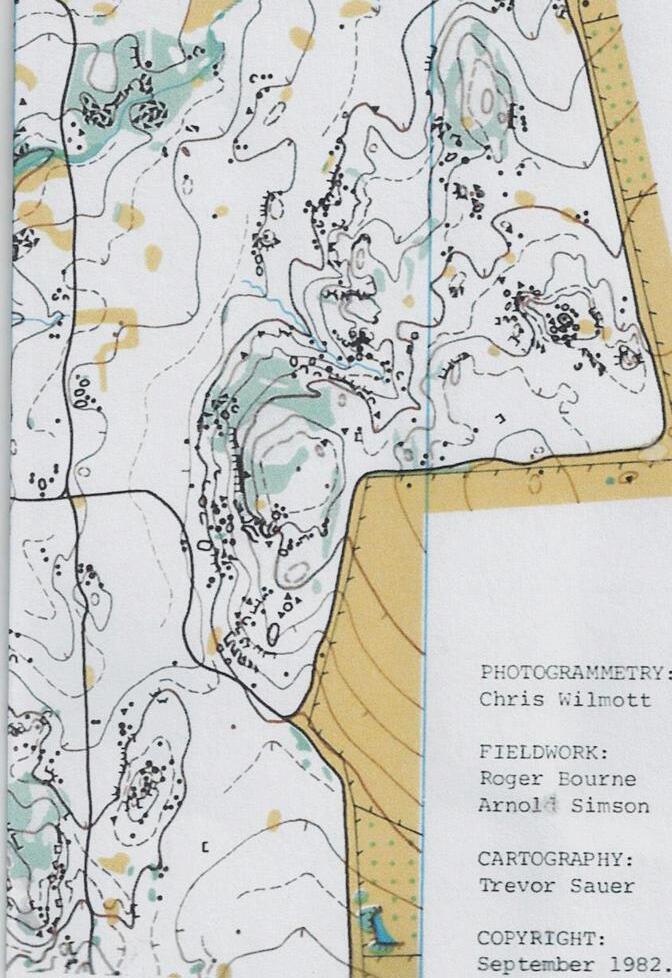
Australian orienteering has lost one of its most accomplished and popular participants with the passing of Bob Allison on 21 September, following a long illness. After being introduced to orienteering in Victoria in the mid-1970s through Yarra Valley Orienteers, Bob moved to Canberra with his family in late 1979, joining Canberra’s Red Kangaroos club (now known as Red Roos).
The following decades saw Bob rise as a formidable masterslevel competitor and contribute to the sport as a mapper, event organiser, course planner, controller and administrator at the local, national and international levels. His significant contribution to Australian orienteering was recognised through his induction into the General Division of the Orienteering Australia Hall of Fame earlier this year.
Bob served as the Public Officer for Orienteering Australia for many years while it was an incorporated body registered in the ACT.
While illness seriously limited his recent orienteering activities, Bob made every effort to get to events where possible, and participate in courses to the best of his ability. He will be greatly missed on the Australian orienteering scene, and particularly by his wife, Judy, daughters Belinda and Jo, and their children, who have all shared his journey through orienteering over many years.
Orienteering Australia website
For many years there has been something seriously lacking from virtually all the maps I have encountered in both major and minor events - slope lines! In 1978 the guru of British mapping, Robin Harvey, visited Australia and gave a series of lectures to mappers. One of his maxims was that whenever there could be any confusion about what's up and what's down, slope lines must be used.
I took his advice to heart, and on maps I drew in the Stanthorpe area, where landform was highly irregular, I used lots of slope lines, resulting in very positive feedback. I rarely saw slope lines on other people's maps, and in the last 20 years virtually never.
I can only conclude that the reason for their absence is one of the following:
1. Maybe mappers think that part of orienteering is figuring out what is up and what is down in difficult areas, without any assistance. Robin Harvey strongly opposed this view. 2. Maybe the idea of slope lines doesn't even enter the mapper's head. 3. Maybe mappers don't even know what slope lines are! In fact, remarkably but not surprisingly, I have found this ignorance to be common in many people with less than 20 years experience.
At recent major events I have had comments from experienced orienteers about the total lack of slope lines on maps that needed them, and the resulting frustration and (often) navigation errors. On behalf of these people, and myself, I implore future mappers to start to use slope lines whenever there may be confusion between up and down. This is especially important in areas with a scarcity of blue watercourse lines.
Trevor Sauer, Sunshine Orienteers, Queensland
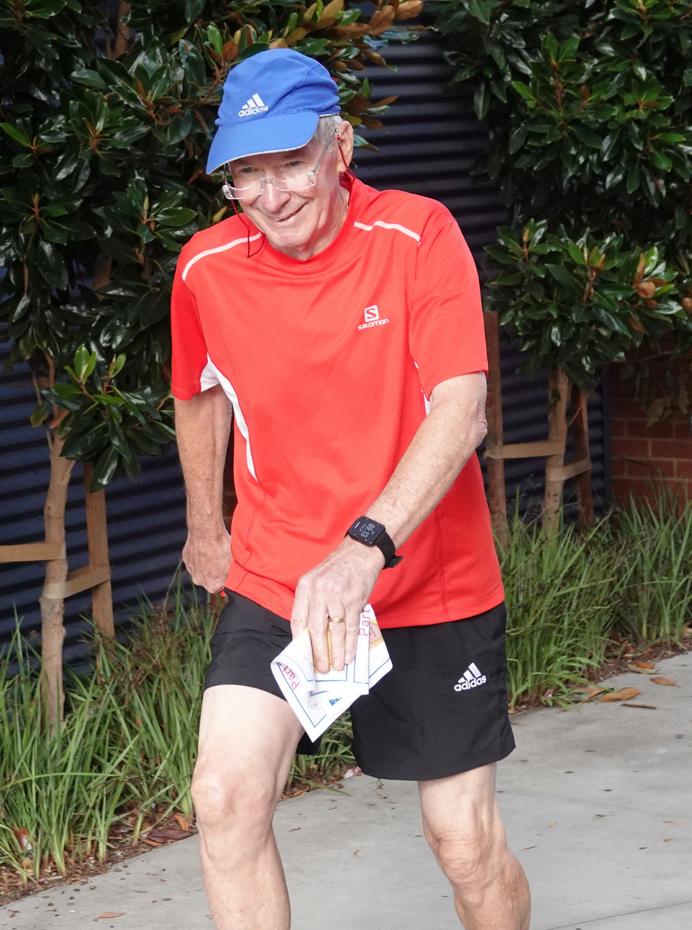

Is this a first in Australia, maybe in the world?



In September, occasional orienteer, Russell Buchanan, flew his self-built plane onto the landing strip at Frazzle, WA! Orienteers who travelled to WA Nationals in 2023 and participated in the event on the schools individual day would have parked on the ‘airfield’. To quote Russell: ‘It’s a homebuilt plane, a Vans RV8, which took me about ten years to build. It was during the build that Simon [BO member] got me into orienteering. It saved my sanity from otherwise spending endless weekends in the shed! I was flying commercial airliners at the time I started but have since gone back to special mission air work. We noticed the airstrip at Frazzle a couple of years ago and decided that this event would be a great opportunity to fly in, so we did!’
Helen Post, WOW orienteer
Exporting course maps made easy
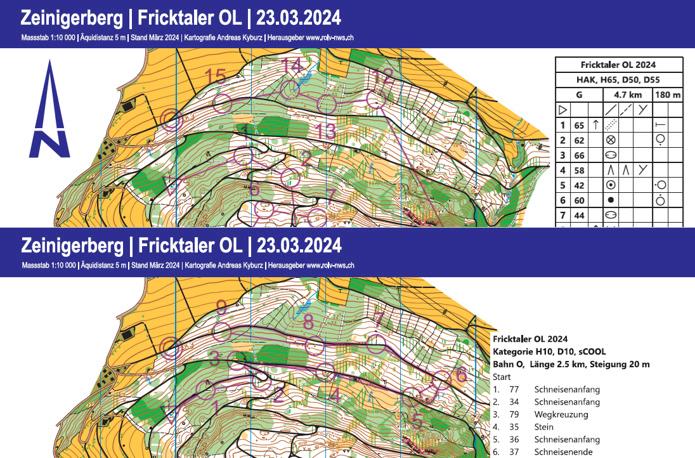
With the Canvas function, OCAD has developed a tool with which different map layouts and scales can be managed in a course project, and printable PDFs of the course maps can be exported with a single click. This is a relief for all those who know how complicated, time-consuming and error-prone this process used to be.
To use the Canvas function, the map file and the map layout must be separated and saved in different files. In a coursesetting project, one or more layout files are loaded as a background map, in addition to the map file, each of which is adapted to a print area (e.g. a layout file for A4 landscape format, and a layout file for A3 portrait format). In the Canvas function, each category (or course) must be assigned to a print area and a layout file. The placement and visibility of course elements (e.g. control description, course title) can also be controlled. Once the Canvas function has been configured, one single click is all that is needed to create all print PDFs.
OCAD AG, Andreas Kyburz, text and images, edited
Quiz answers: 1A, 2A.
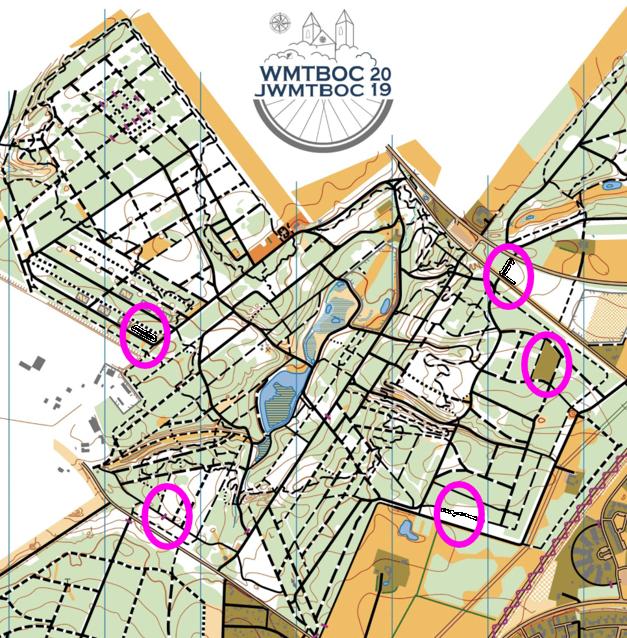
Code Country Code Country Code Country
AUS Australia FIN Finland NZ New Zealand
CZE Czechia FRA France POL Poland
DEN Denmark ITA Italy SUI Switzerland
ESP Spain NOR Norway SWE Sweden
Glossary of acronyms
AO The Australian Orienteer
AOC Australian Orienteering Championships
ASC Australian Sports Commission
ASOC Australian Schools Orienteering Championships
DNF / DNS Did Not Finish / Did Not Start
EOC European Orienteering Championships
EOD Enter On the Day
EYOC European Youth Orienteering Championships
IOF International Orienteering Federation
JWMTBOC Junior World Mountain Bike Orienteering Championships
JWOC Junior World Orienteering Championships
MTBO Mountain Bike Orienteering
NOL National Orienteering League
OA Orienteering Australia
SCJC Southern Cross Junior Challenge
WMTBOC World Mountain Bike Orienteering Championships
WOC World Orienteering Championships
WRE World Ranking Event

















Dec 20-26 Asian O Champs, Asian Junior & Youth O Champs, Chiang Mai, Thailand
Dec 27-31 Xmas 5 Days Sydney, NSW

January 24 - 27
Oceania Championships 2025 Santoft Forest, New Zealand
February 1-2 NZ MTBO Championships Otago, New Zealand
April 18-21 AUS 3 Days Carnival Loddon Shire, Victoria
April 18-21 NZ O Championships Canterbury, New Zealand
May 1-4
May 17-30
June 19-21
June 28 - July 4
July 7-12
WMMTBOC 2025 Murcia, Costa Calida, Spain
World Masters Games 2025 Taipei, Taiwan
Orienteering World Cup Round 1 Idre Fjäll, Sweden
JWOC 2025 Bormio, Italy
Forest WOC 2025 Kuopio, Finland
July 17-20 European Youth Orienteering Championships Czechia
Aug 6-11 The World Games 2025 China
Aug 9-15
Aug 11-17
Apr 24-26
May 27-31
Orienteering World Cup Round 1
Switzerland
Orienteering World Cup Round 2 Sweden
June 28 - July 4 JWOC 2026 Sweden
July 6-11 WOC 2026 Italy
Aug 8-14
WMOC 2026 Rzeszów, Poland
Aug 12-16 Orienteering World Cup Round 3 Czechia
Aug 25-30
Preliminary dates
Sept 9-13
Preliminary dates
WMTBOC & JWMTBOC Mora, Sweden
WMMTBOC 2026 Forres, Scotland, UK
Sep 23-27 Orienteering World Cup Round 4 and EOC 2026, Lithuania
Sep 26 - Oct 4
Oceania Championships 2027, ASOC and SCJC 2026 ACT
May 21-29
Preliminary dates
WMOC 2027 Japan
June 27 - July 3
Preliminary dates JWOC 2027 Kłodzko Valley, Poland
July 14-18
Preliminary dates WOC 2027 Hungary
2024 and 2025 – STATE CHAMPIONSHIPS AND CITY
WMOC 2025 Girona, Spain
WMTBOC & JWMTBOC 2025 Warsaw, Poland
Aug 26-31 EOC 2025 & World Cup Round 2 Antwerp, Belgium
Aug 26-30
Prelim dates
Asian Junior & Youth O Champs Shitara, Japan
Sep 5-7 AUS MTBO Championships WA
Sep 25-29
Orienteering World Cup Round 3 Uster, Switzerland
Sep 27 - Oct 5 AUS Champs Carnival Brisbane, Queensland
Jan 24-26
Preliminary dates Oceania Champs 2026, Sprint Central Coast, NSW
Apr 3-6 Australian 3 Days and Australian Championships 2026 Tasmania




